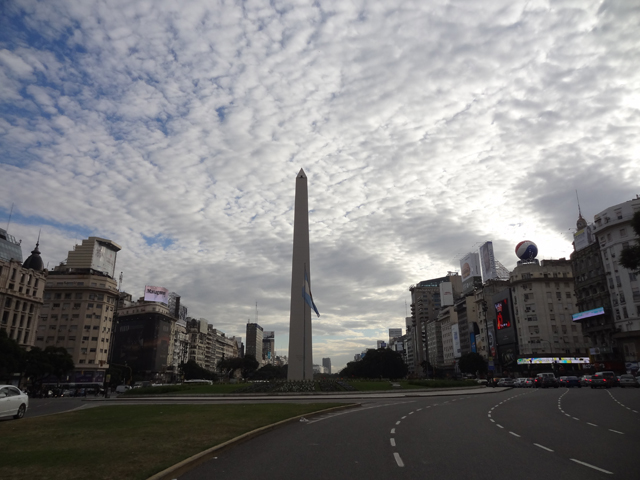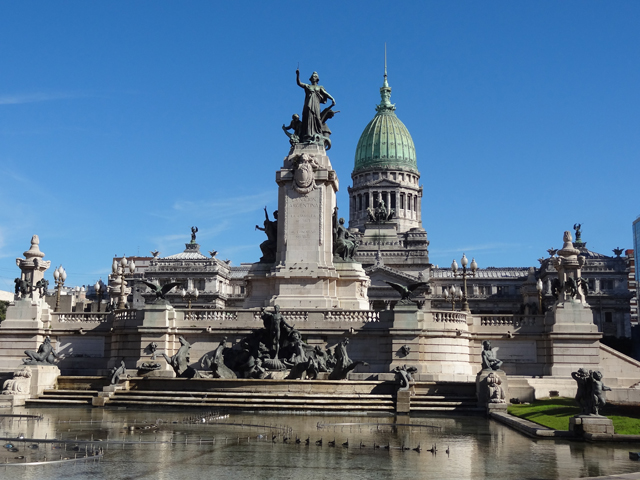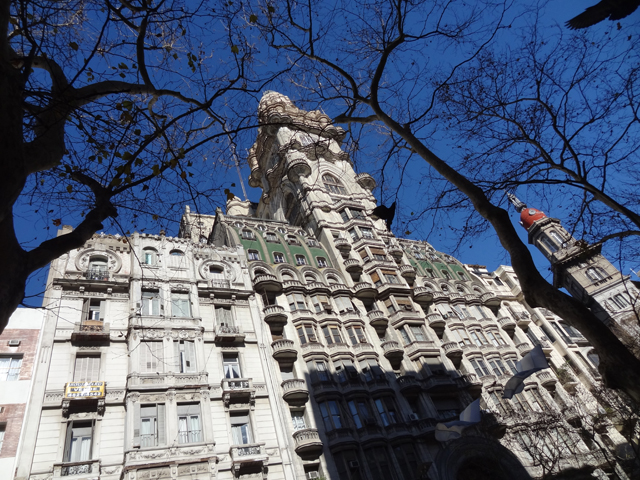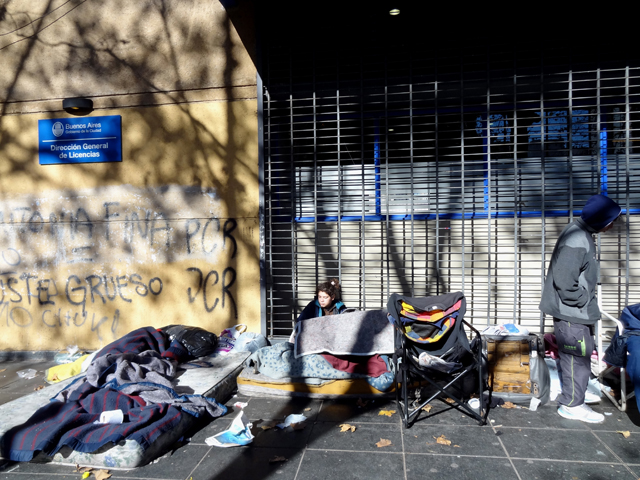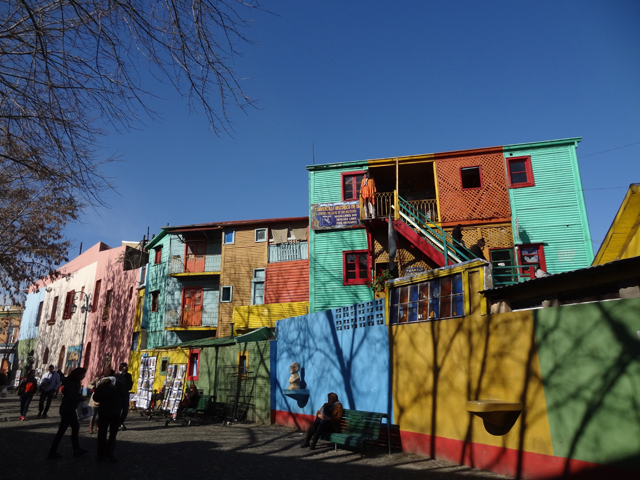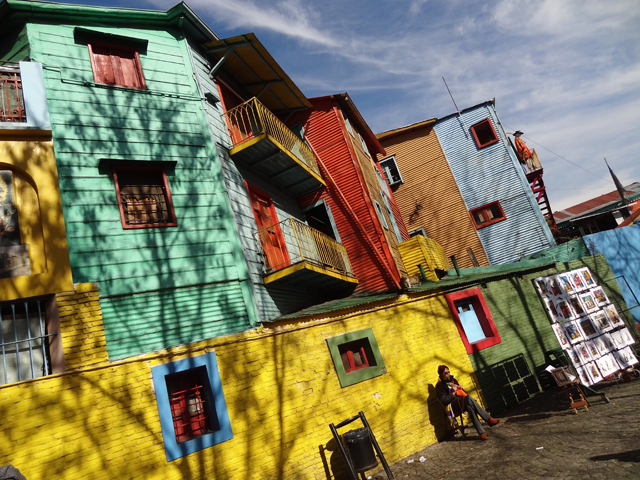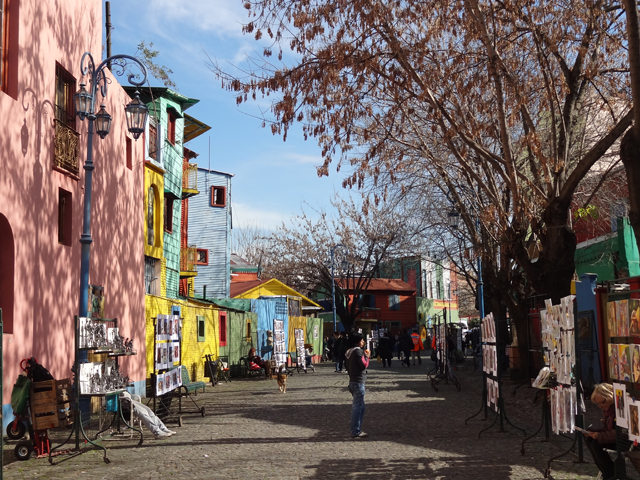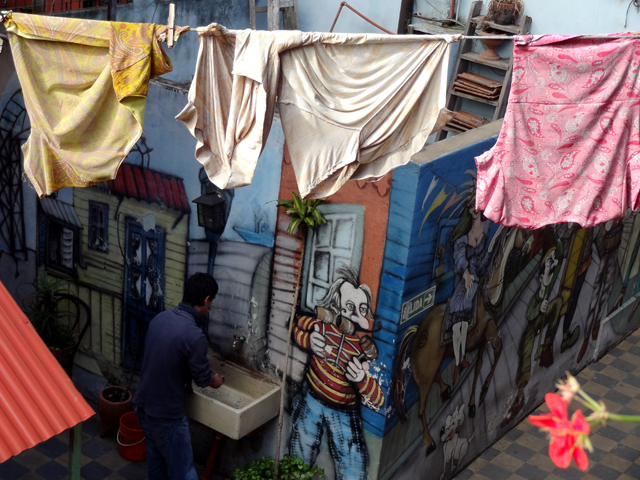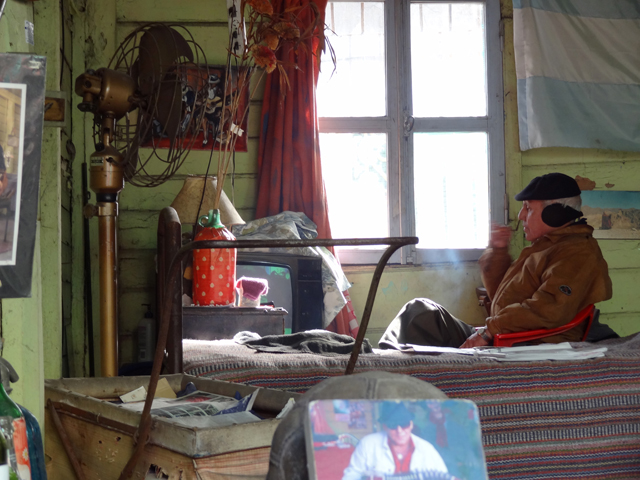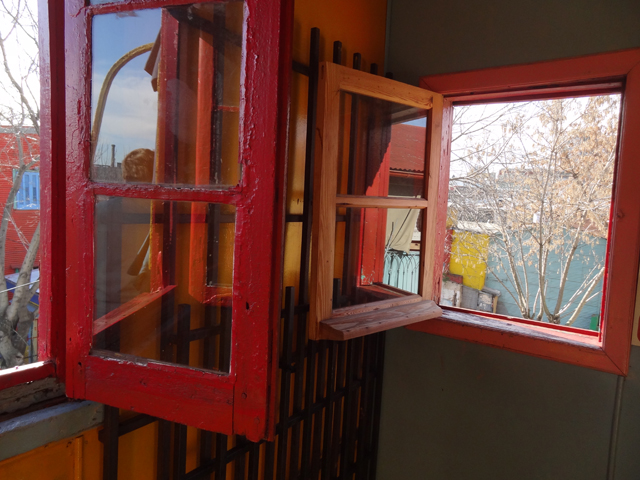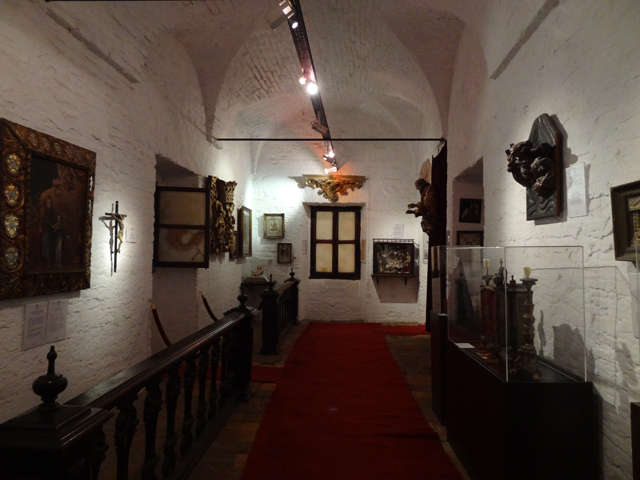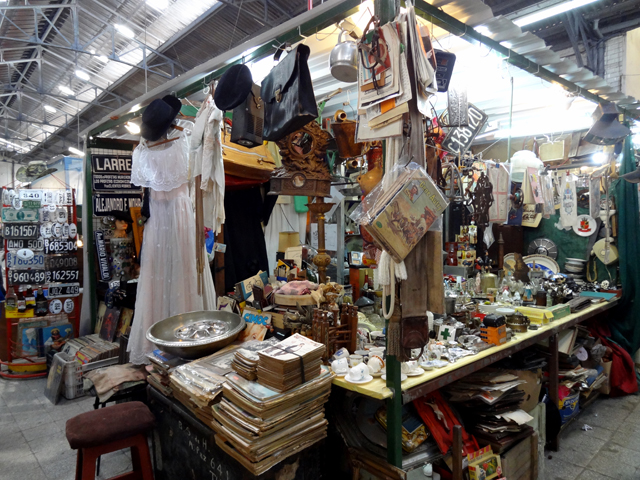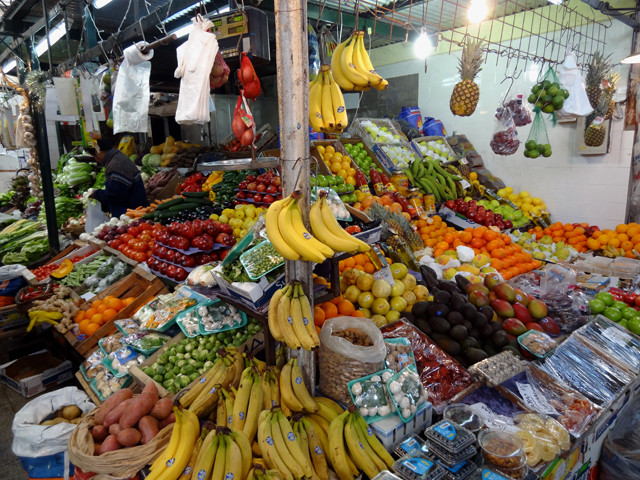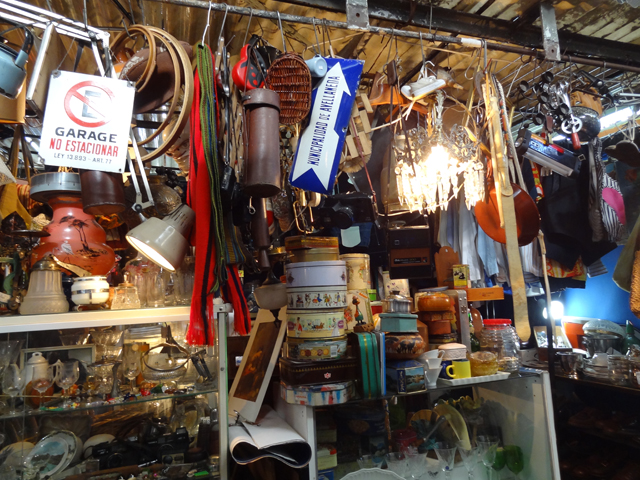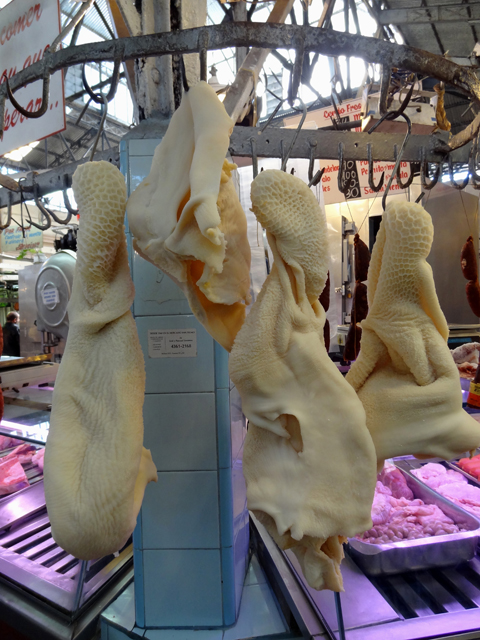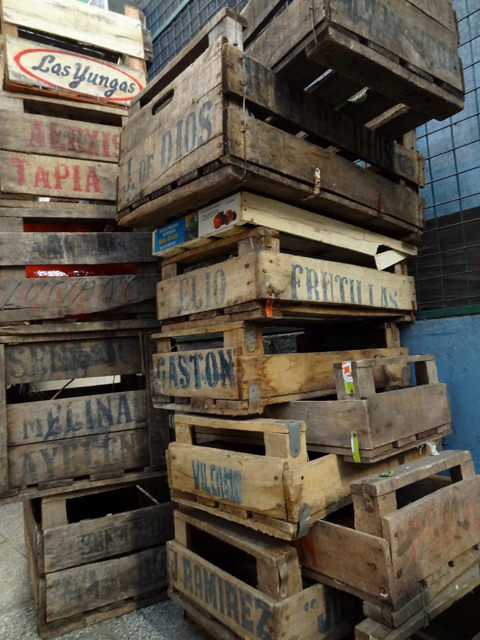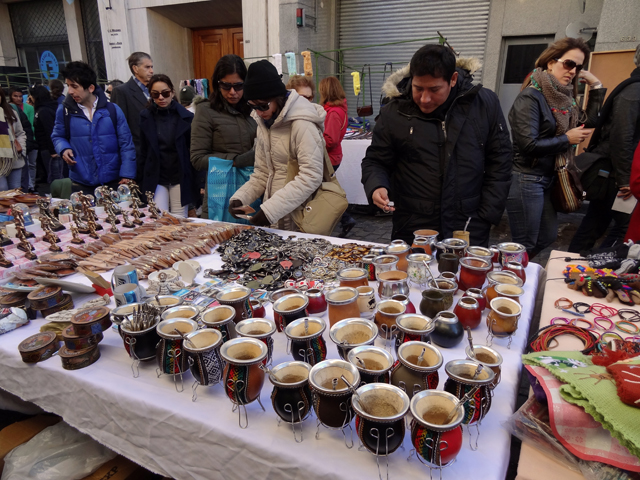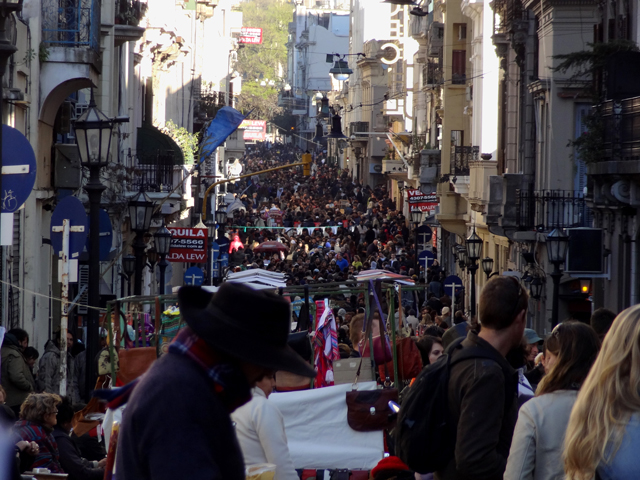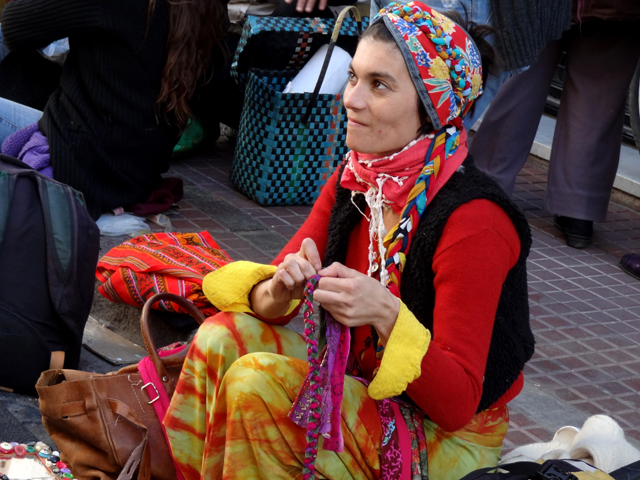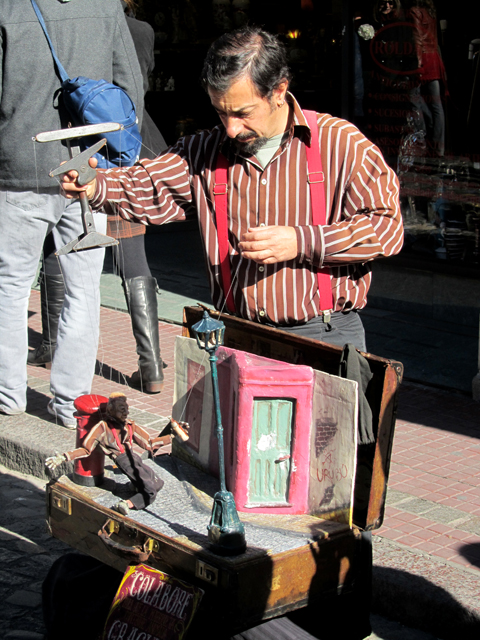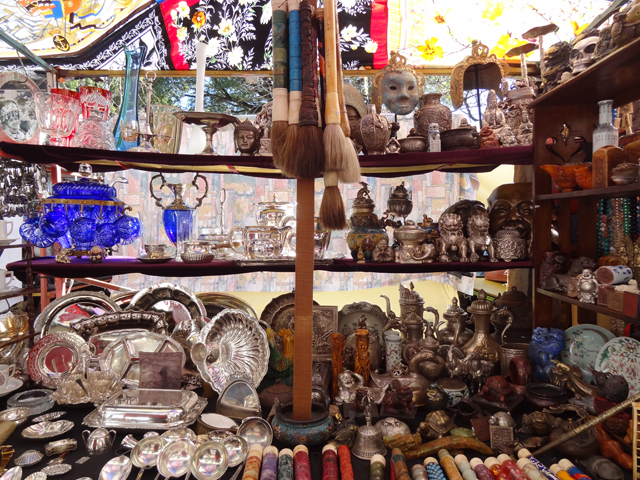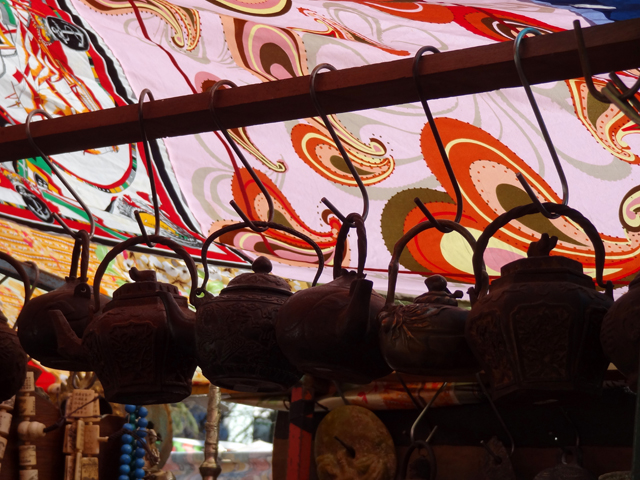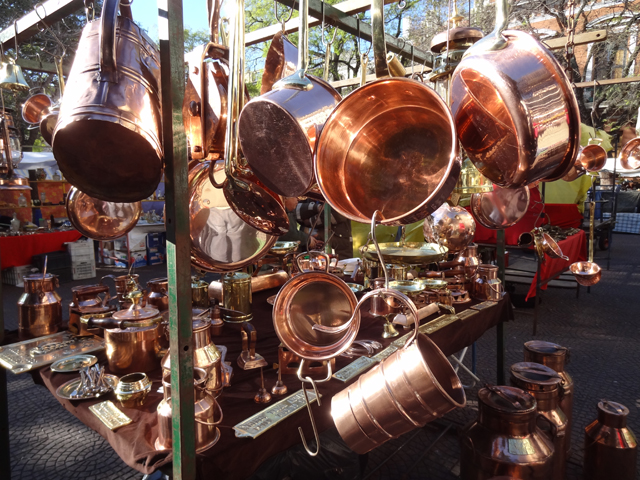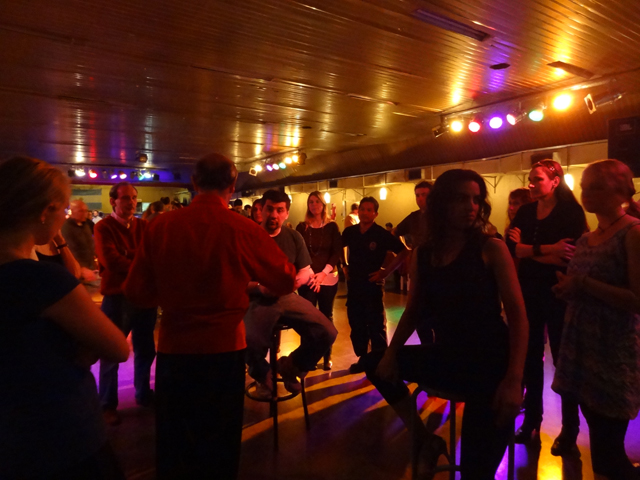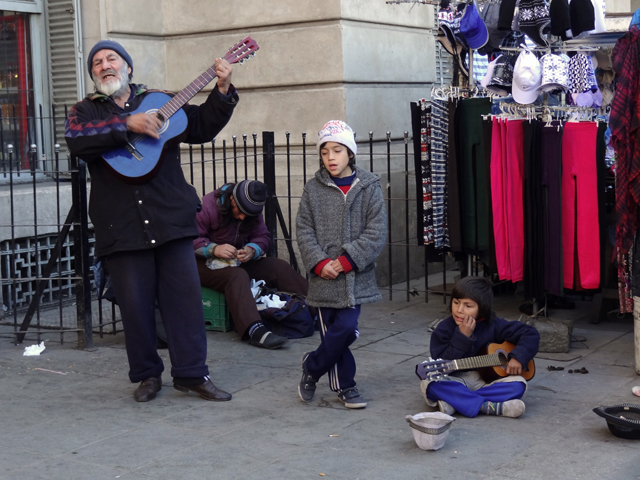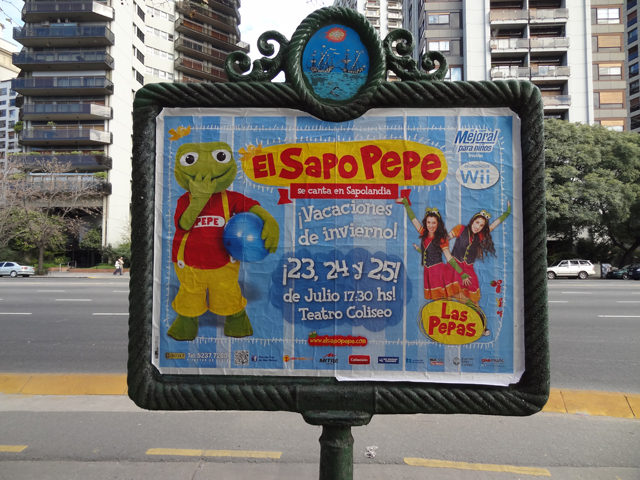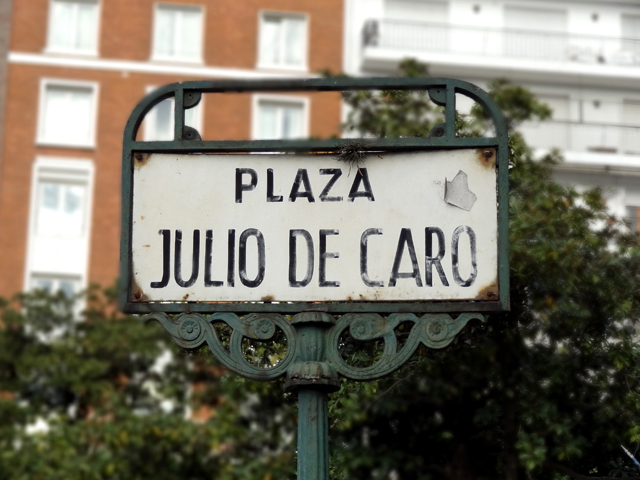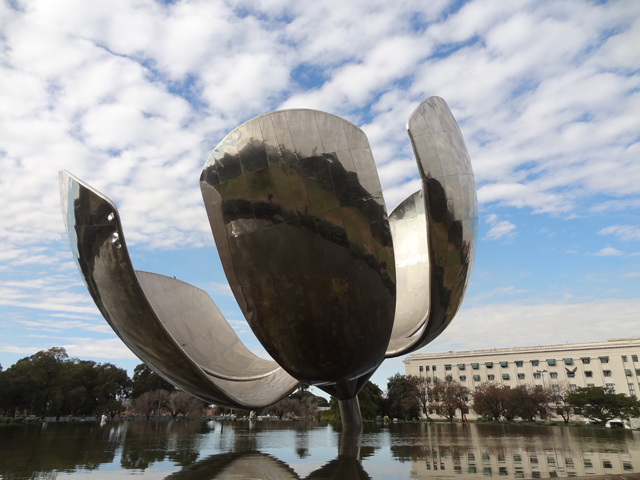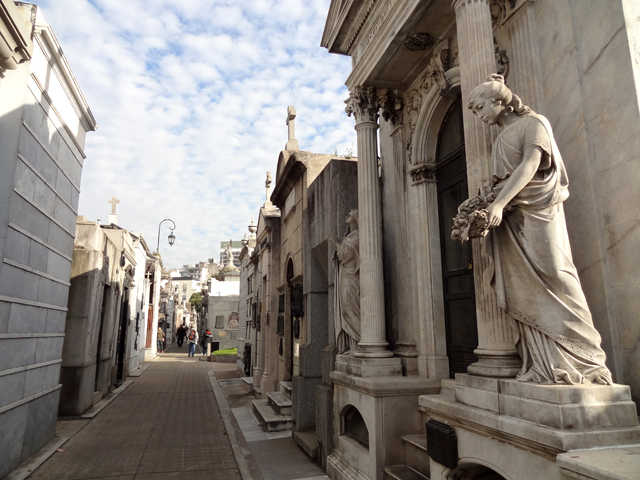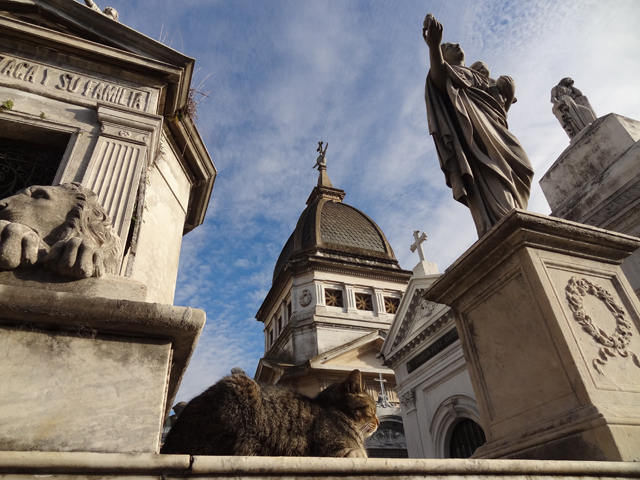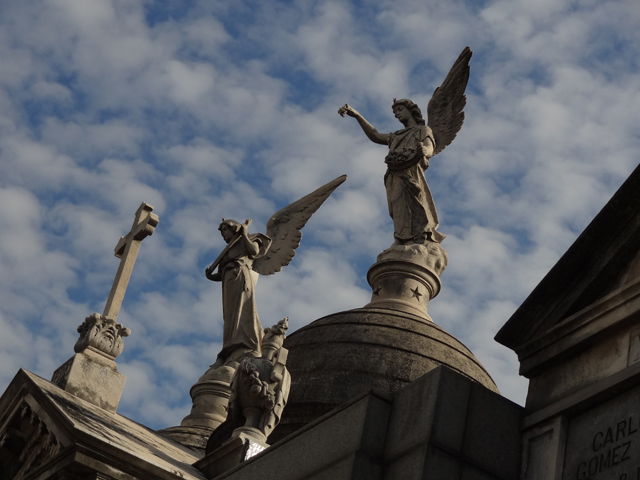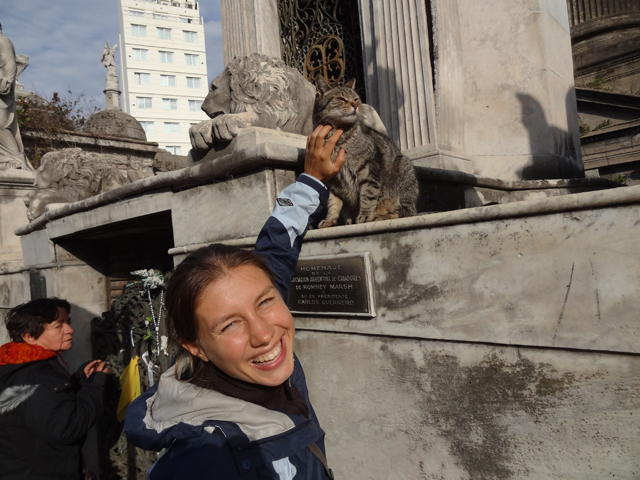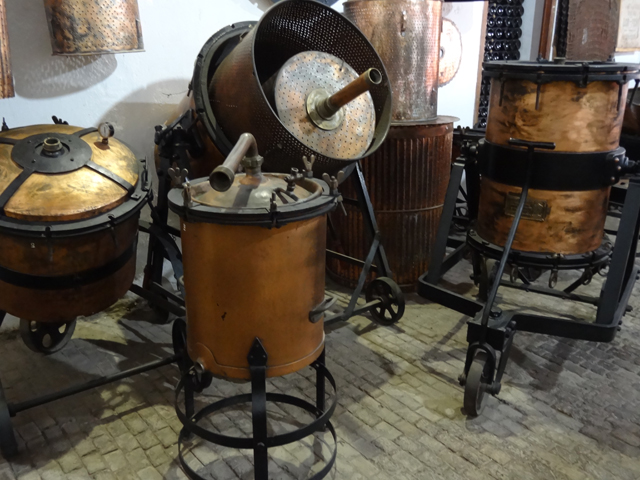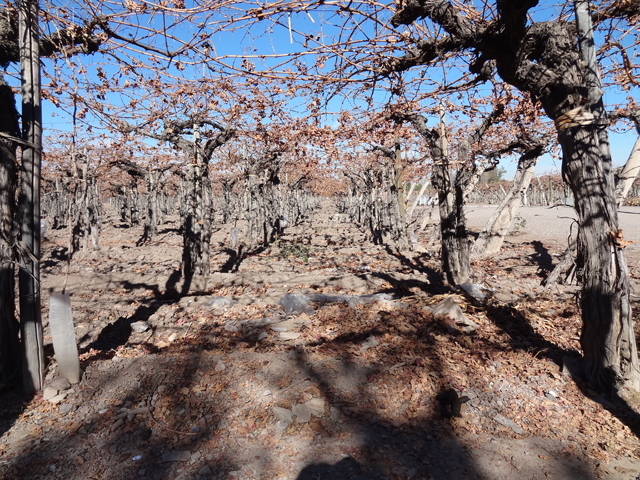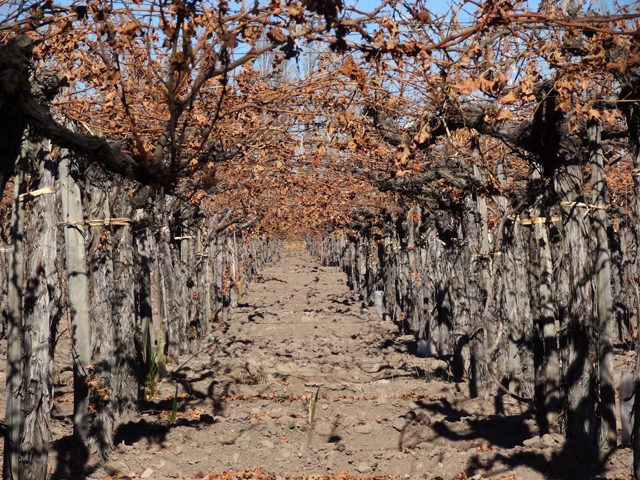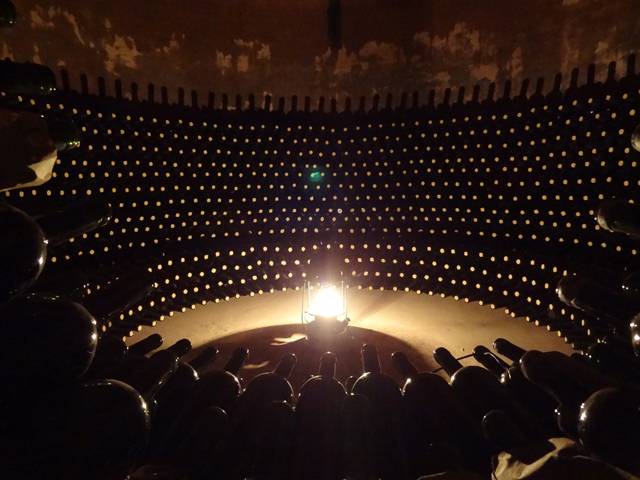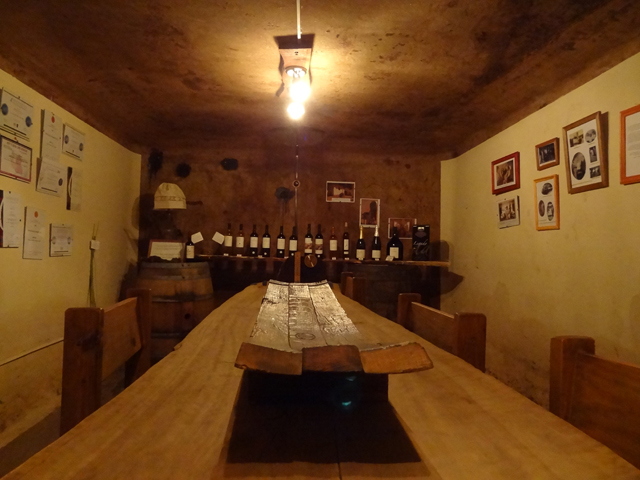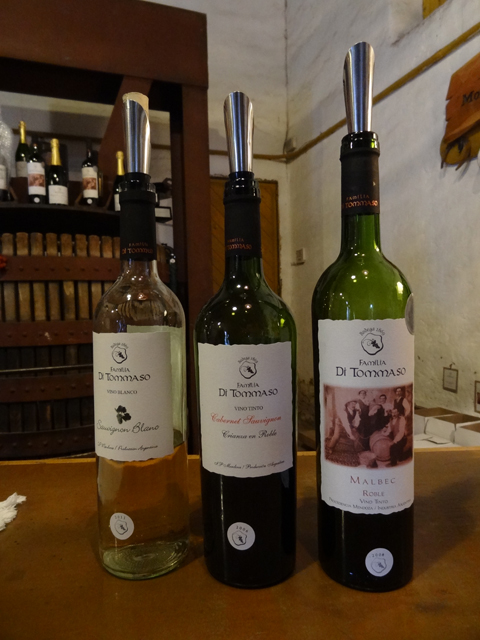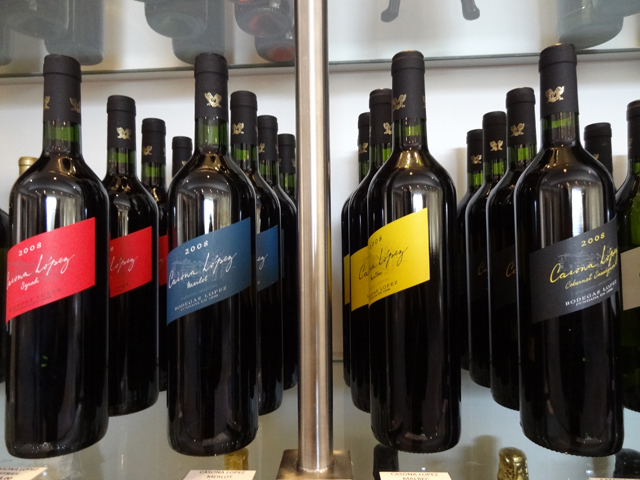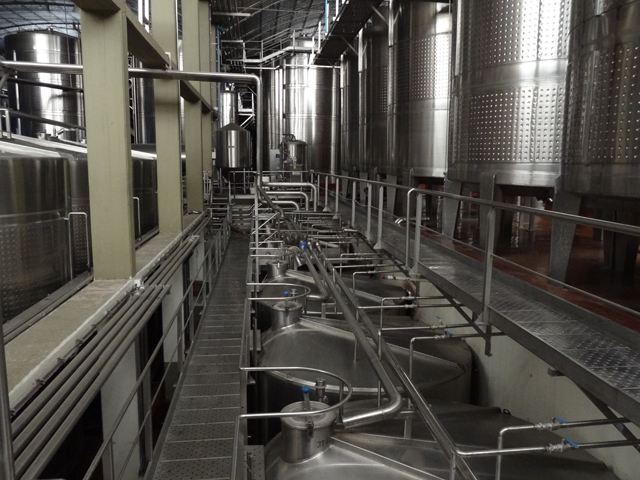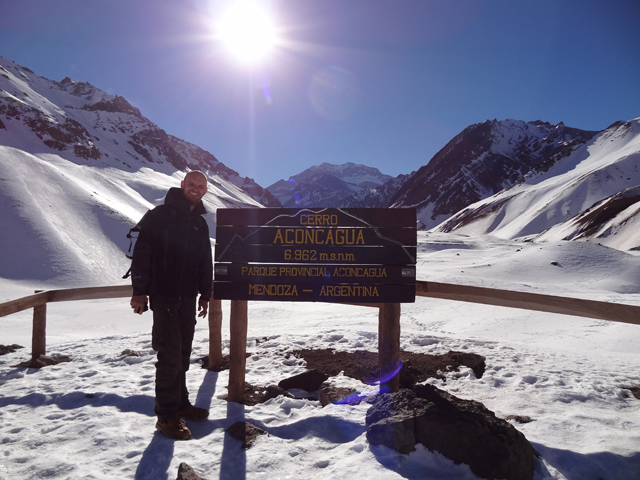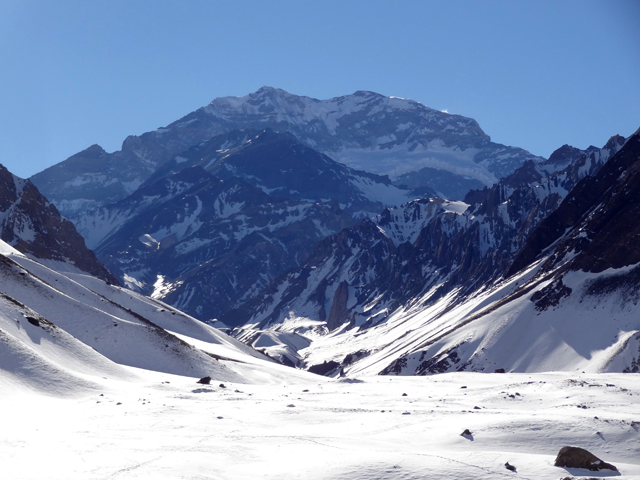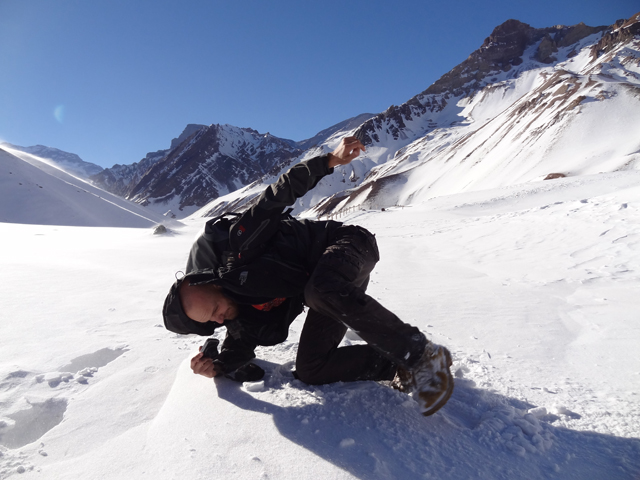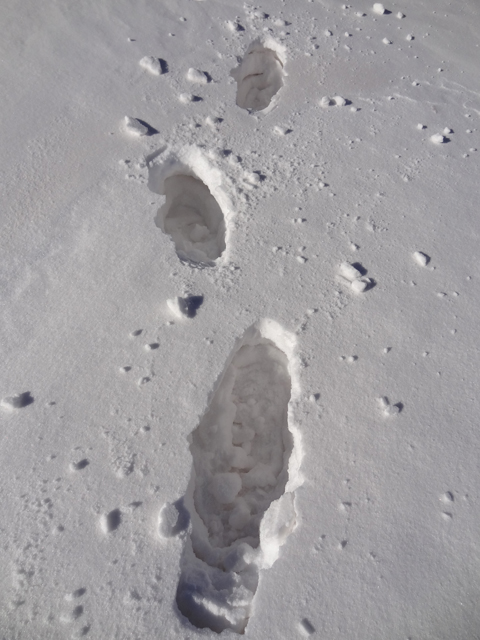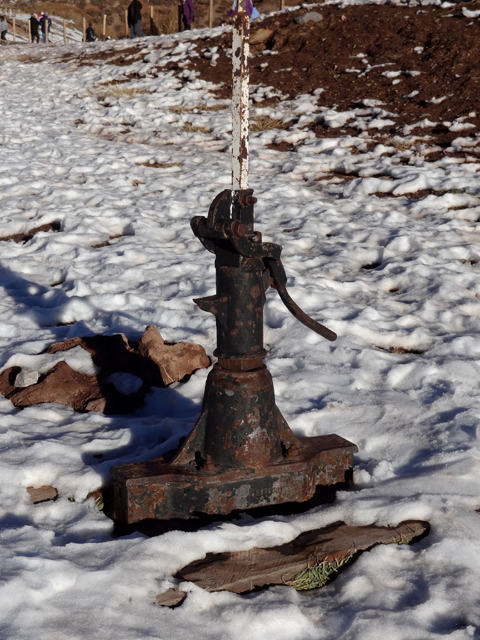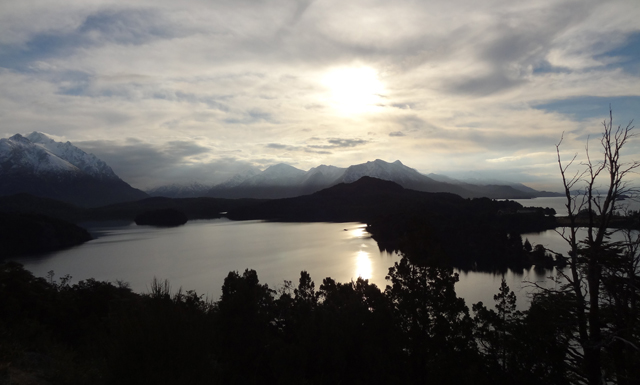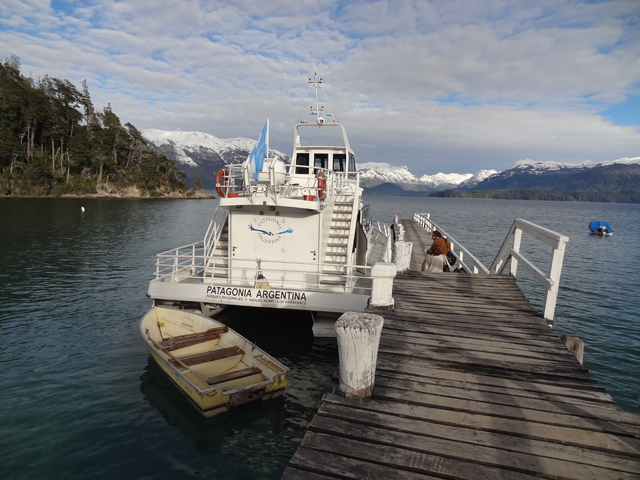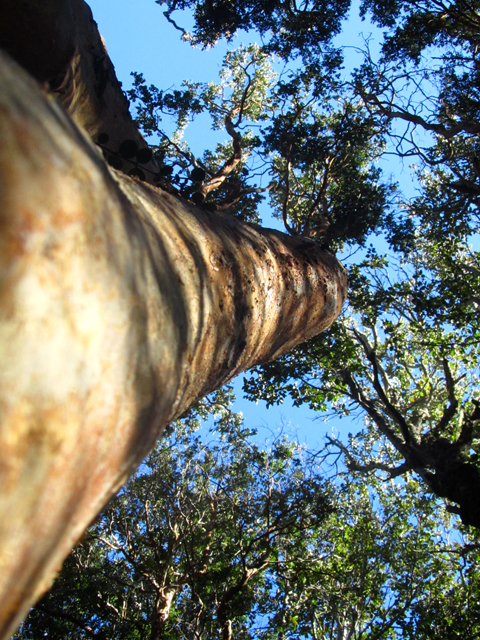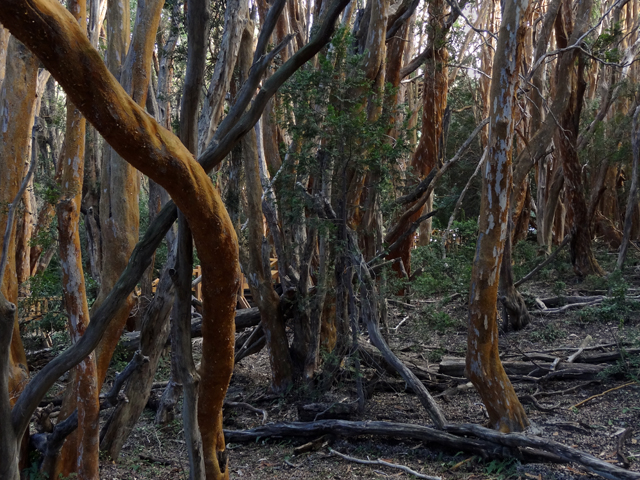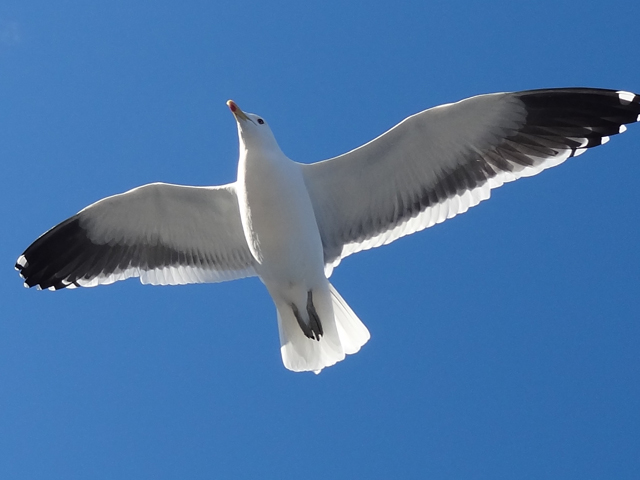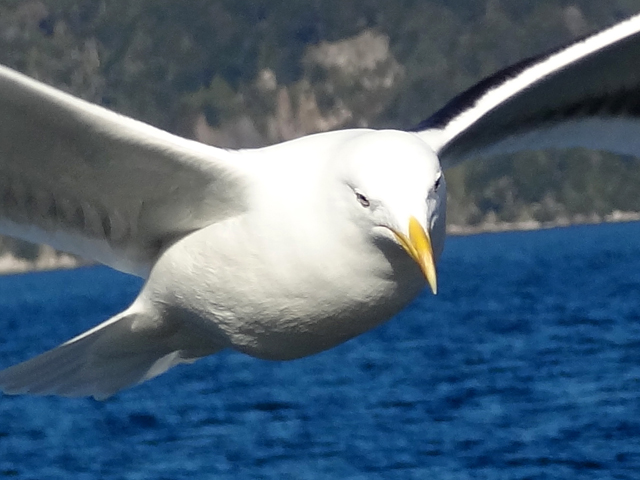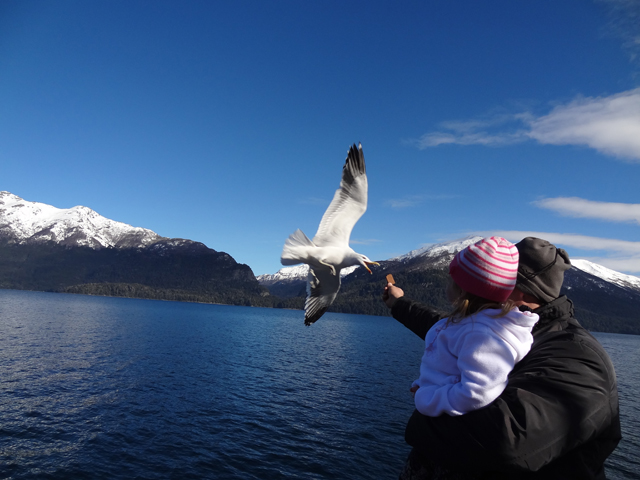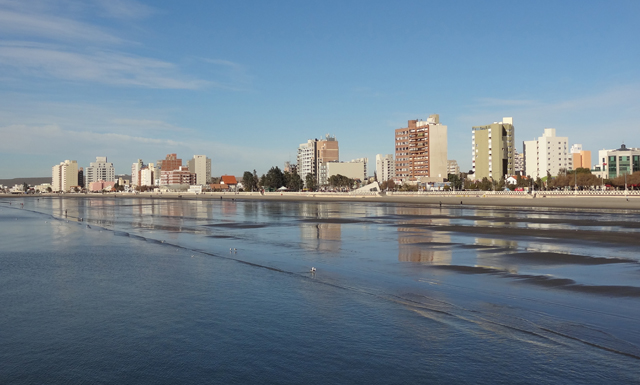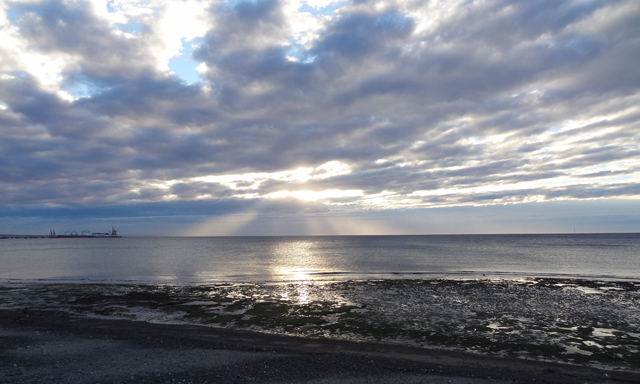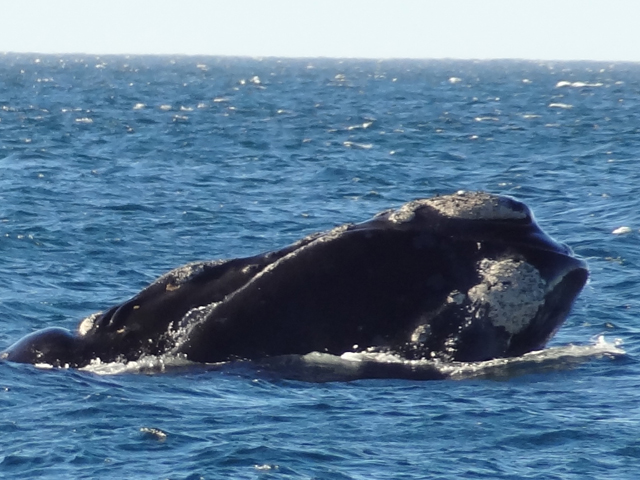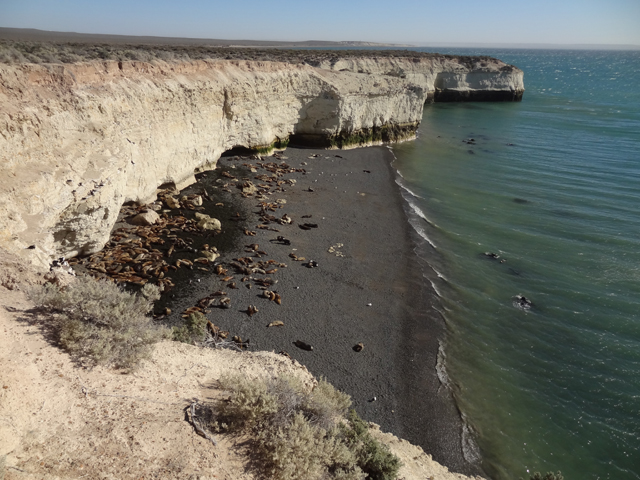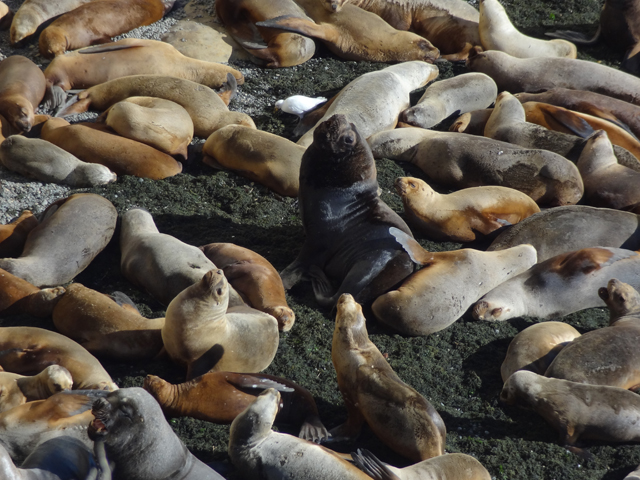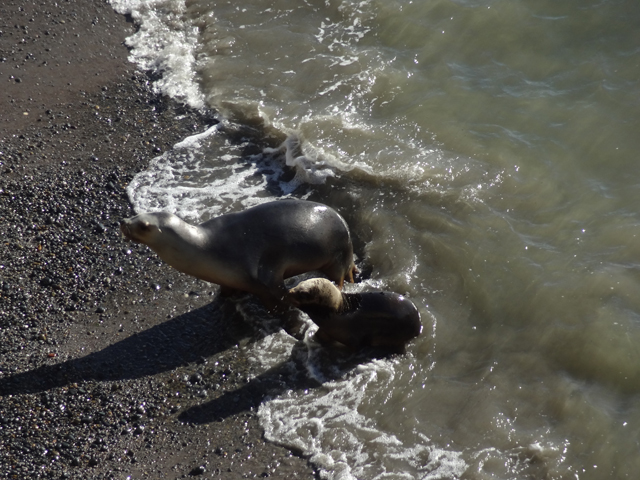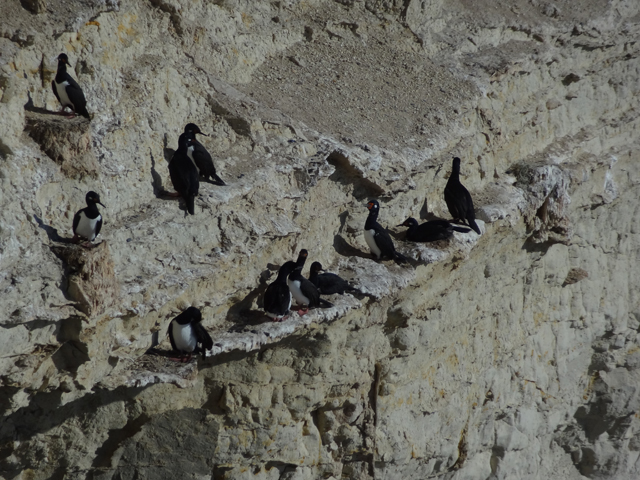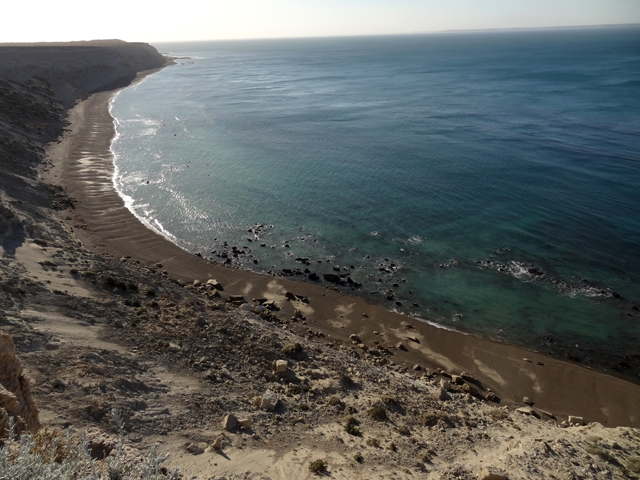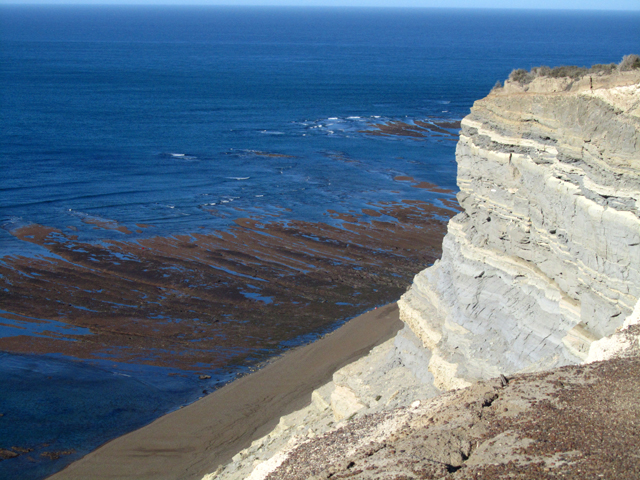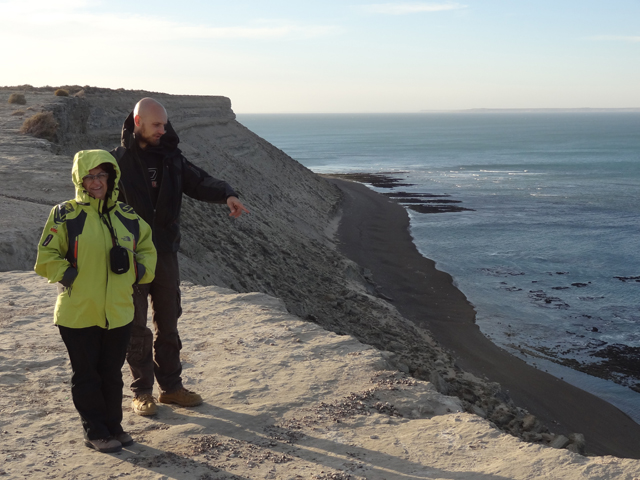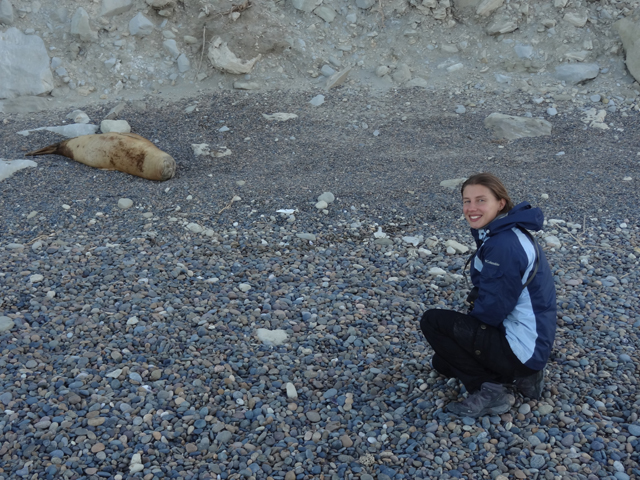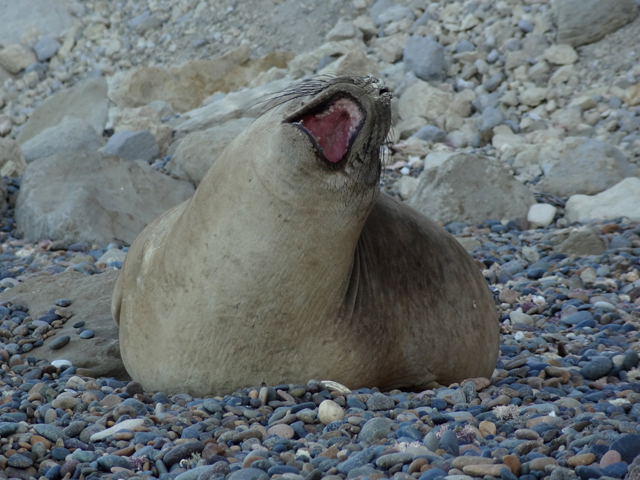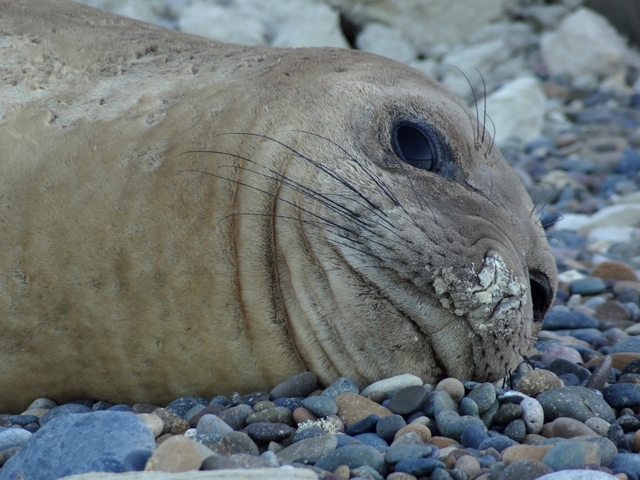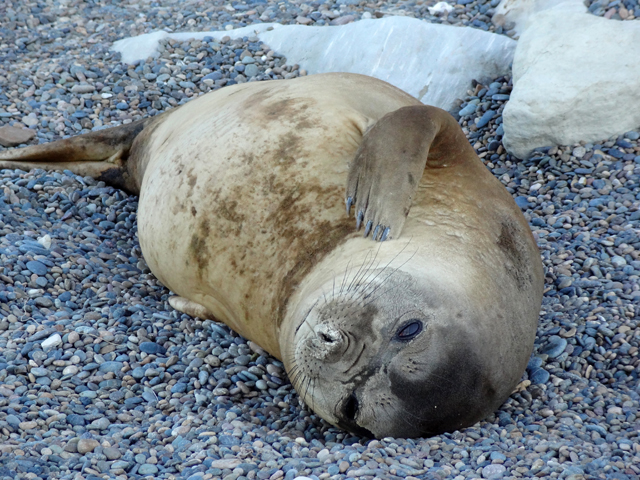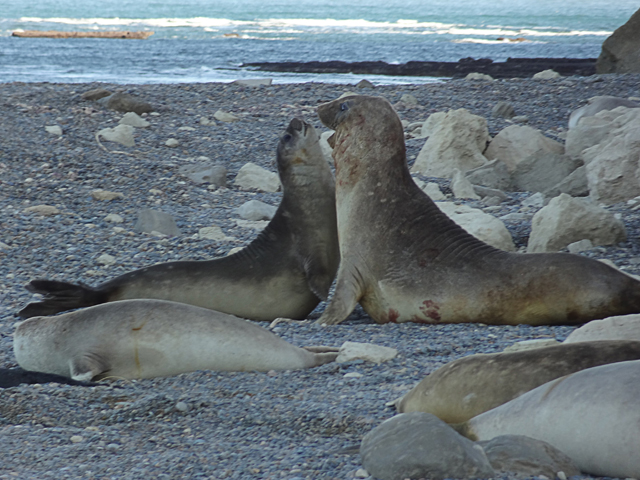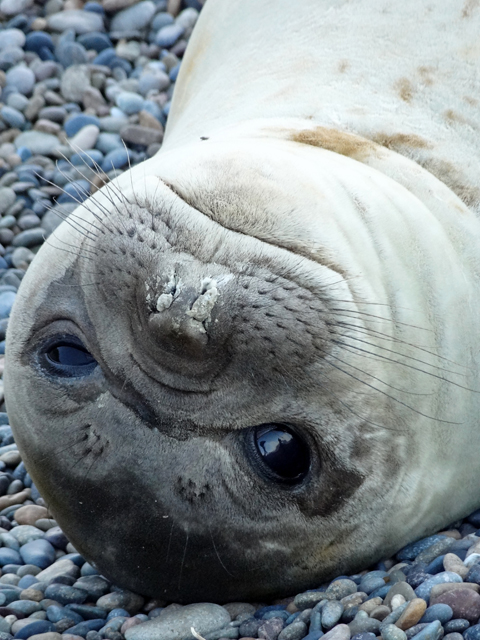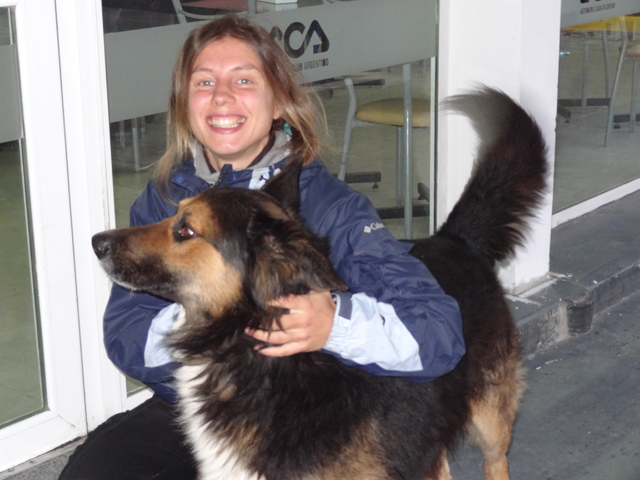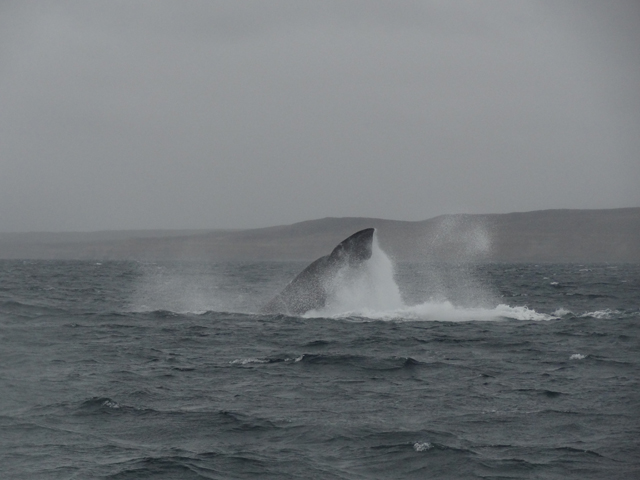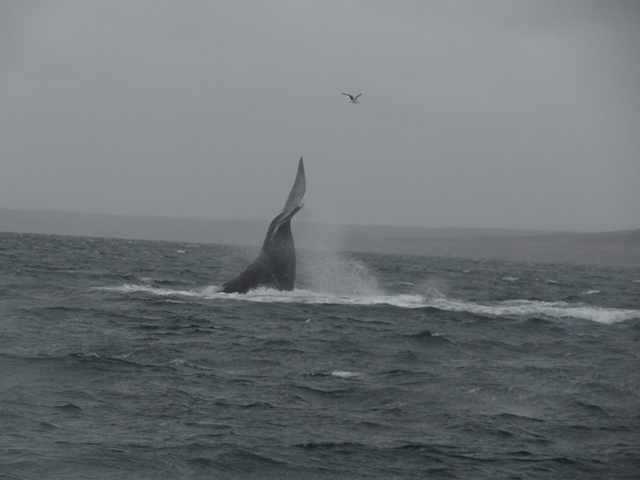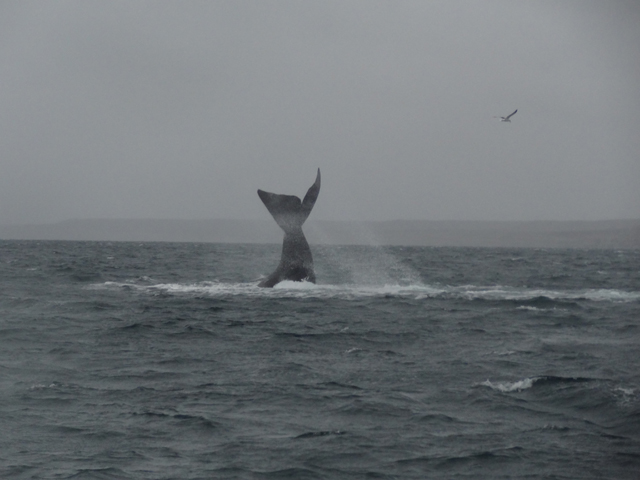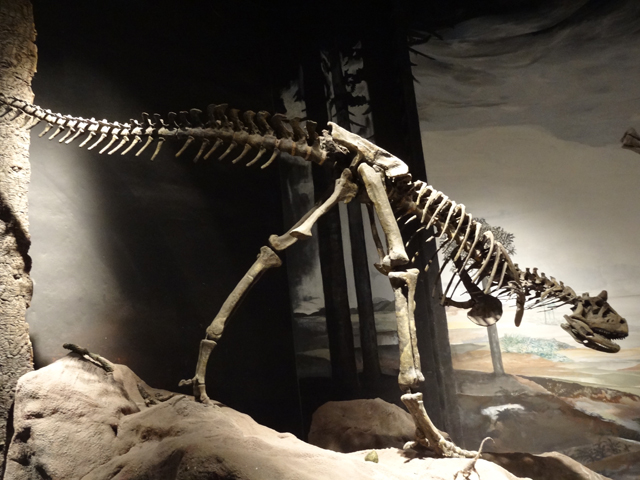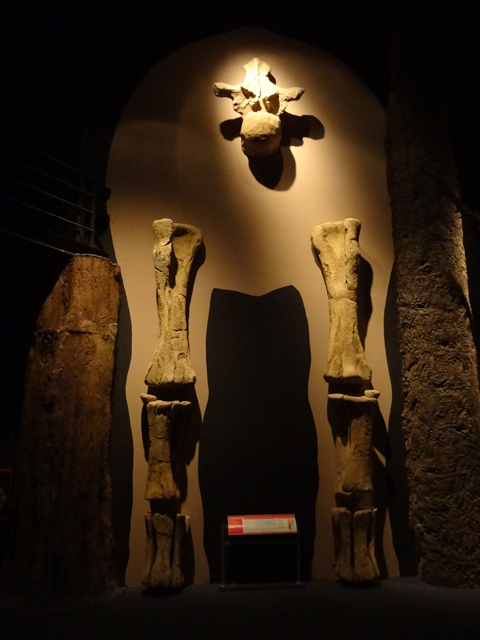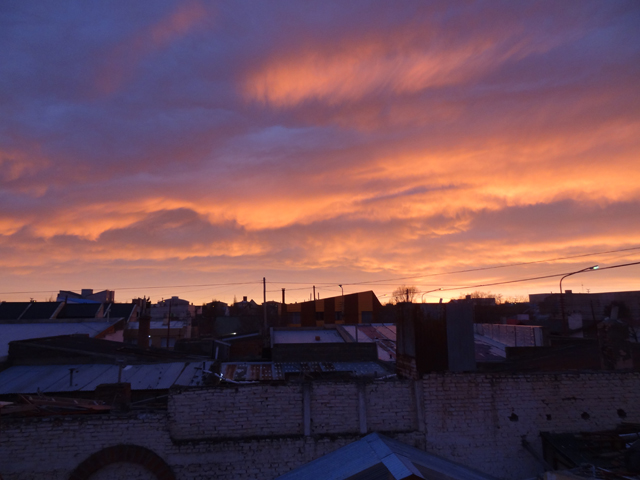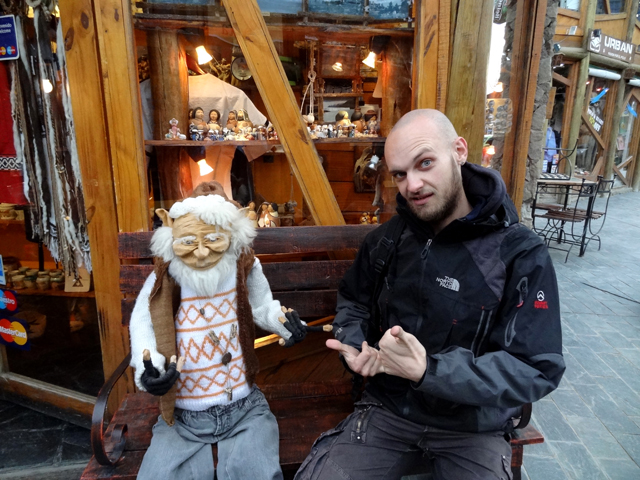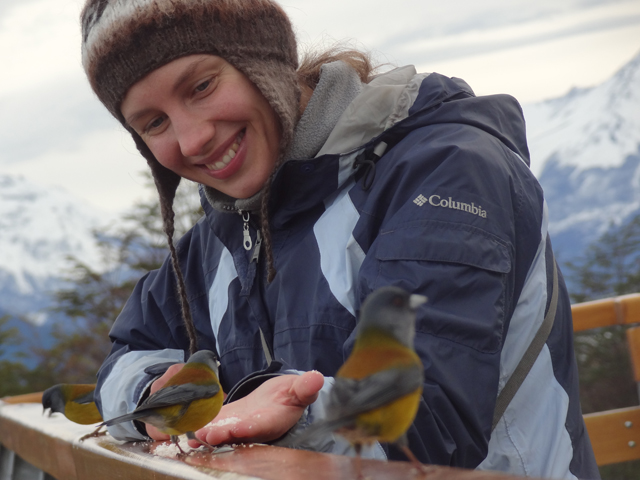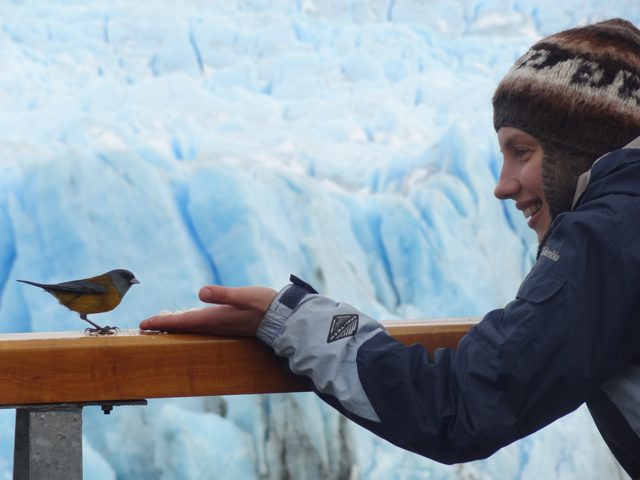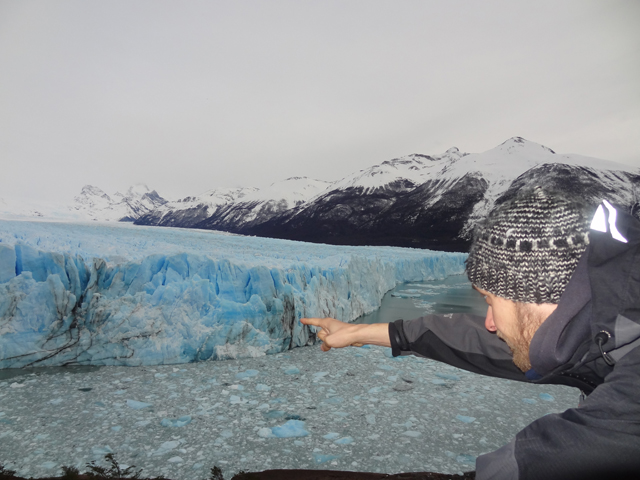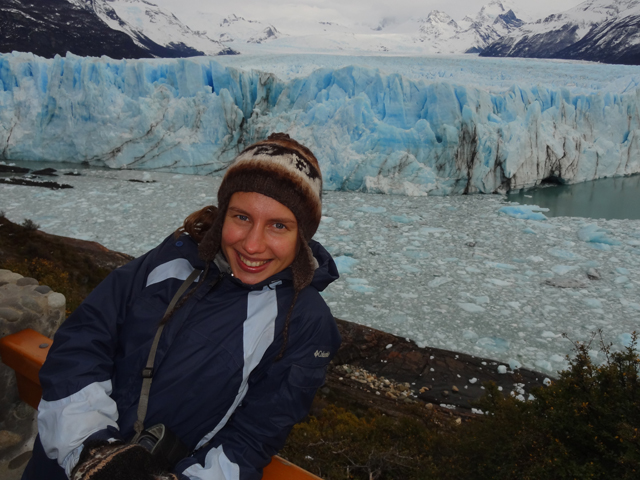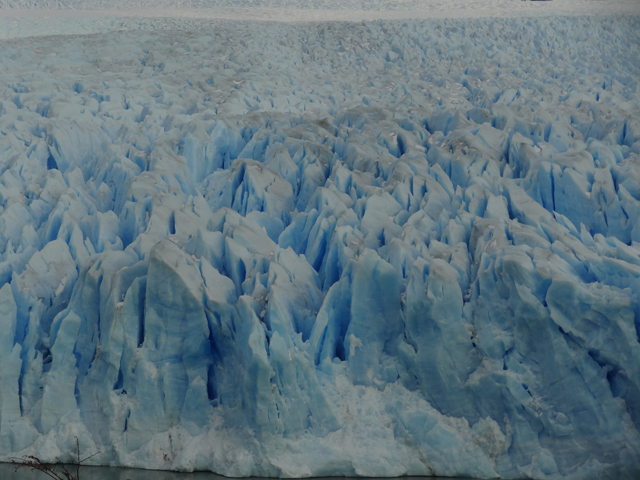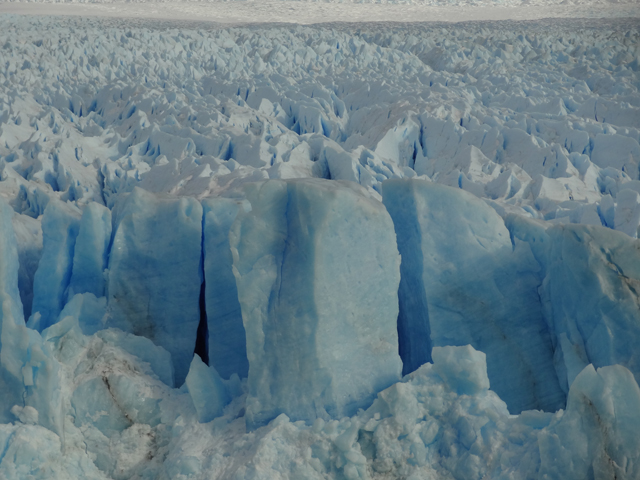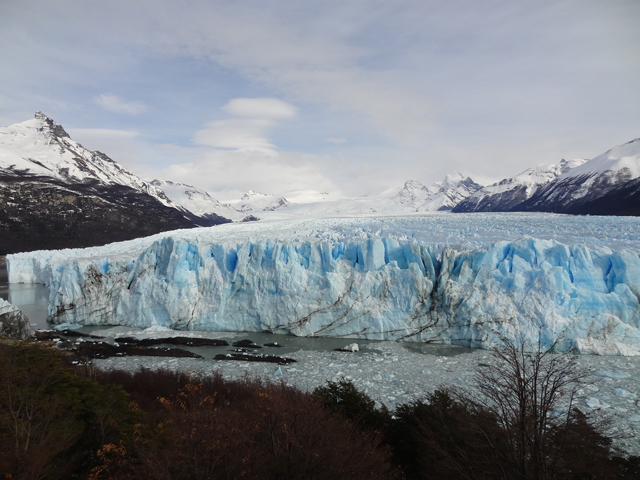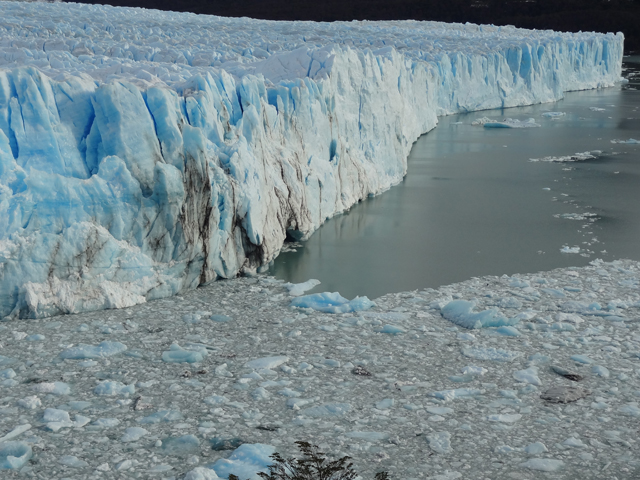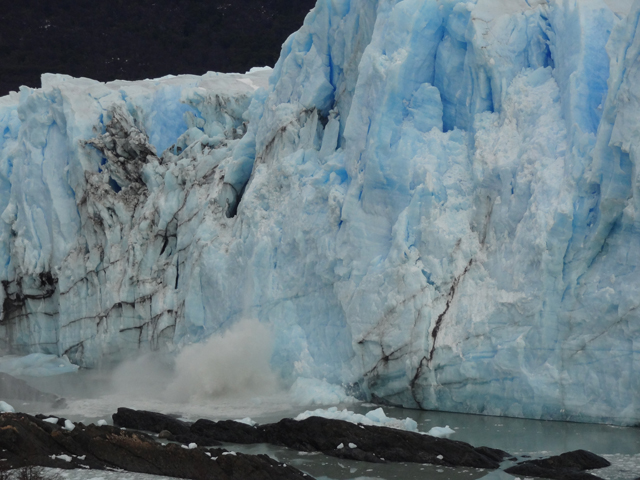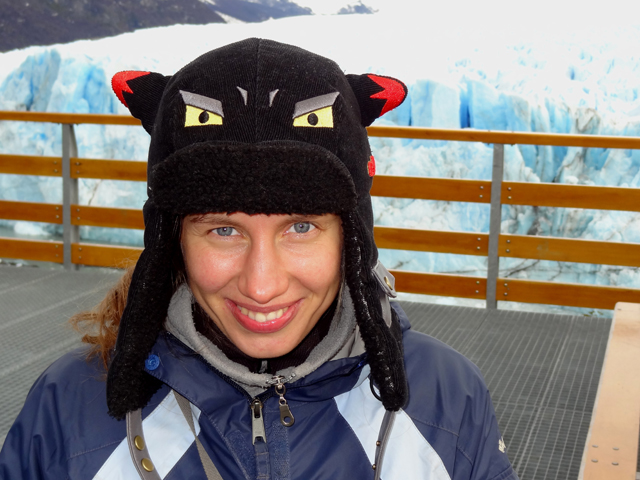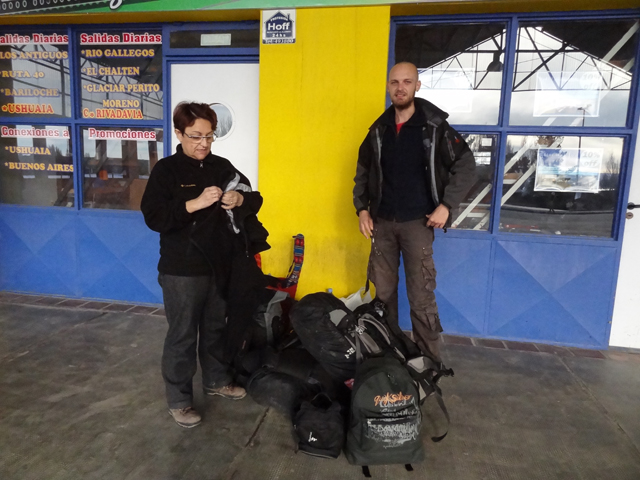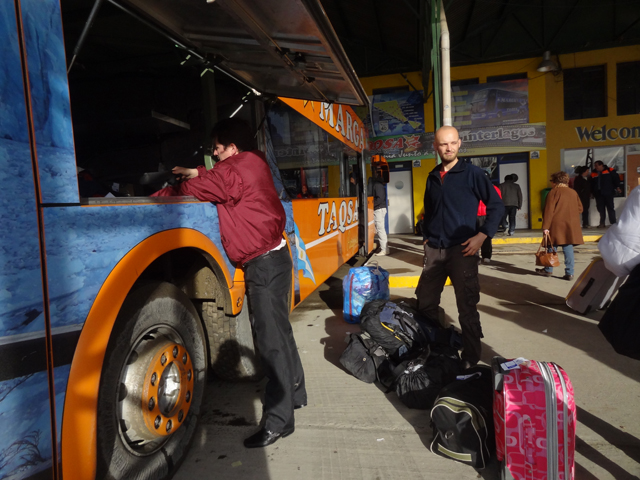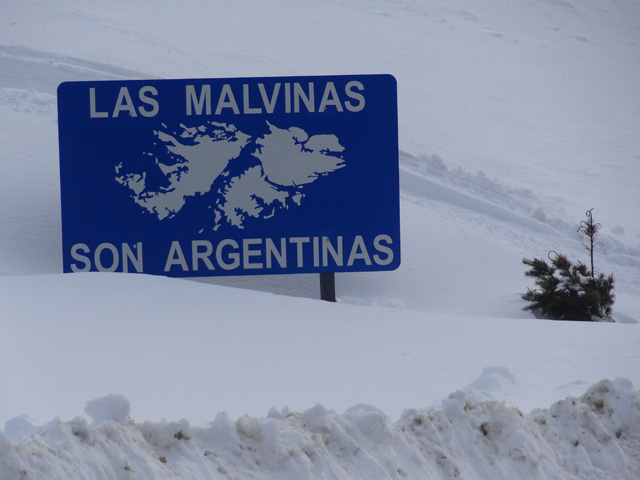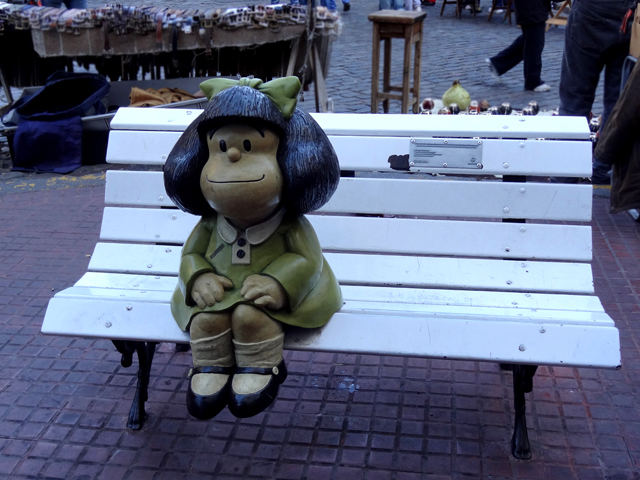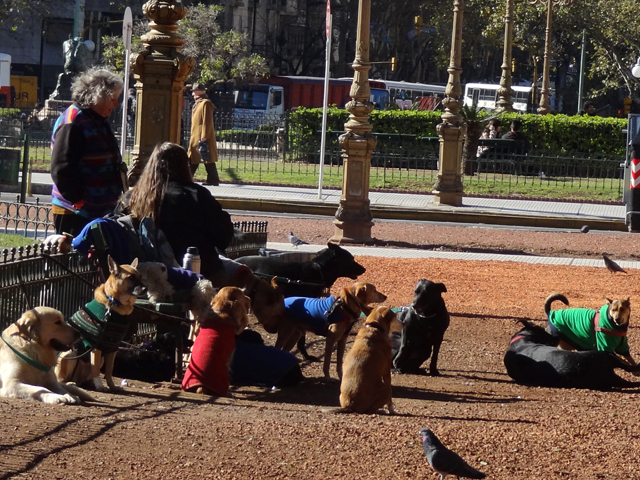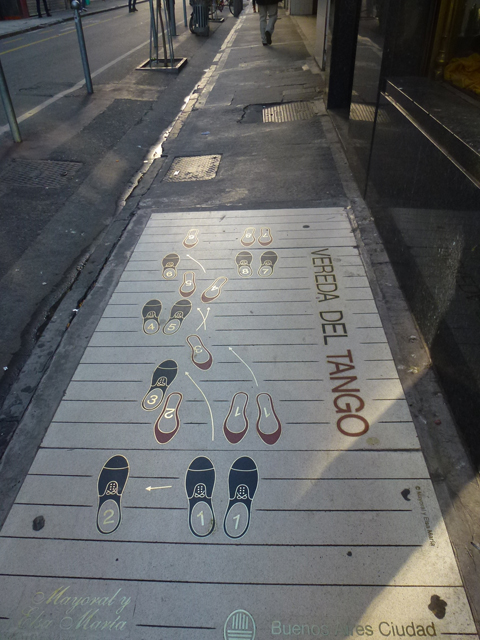Argentina - amazing animals, glaciers and strikes
Buenos Aires:
We arrived at Retiro station in Buenos Aires and walked the whole main avenue Avenida de 9 Julio to Hostel Sol. For the next few days the three of us (Jordi's mum joined us for her vacation) stayed here in the antique building of the hostel in a room so huge that it even had an old piano. Apart from us, there were a lot more people for whom the hostel was a semi-permanent abode: street art hippies (a drum player who'd insist on rehearsing her whole repertoire on a table in the common area, a photographer who'd occupy another whole table to make cute little framed collages with his city photos for sale), a strange martial arts teacher from Italy with a twisted sense of humour, an English-language teacher from US, a Colombian girl finishing her business administration degree and hoping to get a job in Argentina, a Latvian (or according to him - Soviet) guy who'd been robbed of a bag with 6K euros after his arrival in Argentina and was passing his time in the hostel on an expired tourist visa carrying out some minor construction work for the hostel in exchange for free accommodation, Brazilian girls with unknown occupations but, according to the Latvian guy, insatiable sexual appetite, - all in all, a very colourful lot.
The sightseeing agenda for Buenos Aires took a few days to complete and included:
Day 1: The areas of Monserrat where we saw a lot of aspiring "dog whisperers" walking huge packs of dogs that locals leave with them for the whole day (sort of hundegarten); colonial Centro and Puerto Madero (an old port which these days serves purely tourism purposes).
Falklands War veterans' protest signs at Plaza de Mayo (see "Las Malvinas son Argentinas" below):
Madero port:
Day 2: The rainbow-coloured La Boca with its famous Caminito street which without a doubt is the most charming area of Buenos Aires and for this reason the most crowded and touristy one as well (it was full of souvenir shops and restaurants with beef menus and tango shows); and La Recoleta area where we visited an interior design shop and Iglesia del Pilar with its cave museum.
La Boca, Buenos Aires:
Recoleta church:
Day 3: San Telmo Sunday antiques market and a really long pedestrian Defensa street with dozens of arts and crafts shops. By then it was high time for us to try some tango, so Jordi and I headed to the milonga called La Viruta in the fancy Palermo area, where we had 4 hours of nonstop free beginner classes of milonga, rock-n-roll and tango. Luckily for us, nobody (except for me) in that place seemed to mind that we were wearing our trekking clothes and shoes (as that's all the wardrobe we have in our bags for cold climates) and we were even asked to demonstrate to the few dozens of other beginners along with a few more couples what we'd learn by the end of the class :-). Well, all I can say is that you can tango without tango shoes, but from a female perspective it's a much tougher challenge to make the steps look as feminine as in high-heeled shoes. After the classes we stayed till almost the morning practising all the three dances we'd just learned and watching the few hundred locals in their best element - playing the fascinating and sensual tango game.
San Telmo antiques market:
Defensa street market:
Milonga "La Viruta":
Day 4: On our last day in Buenos Aires we went to see the famous Floralis Generica (the huge metal UN Flower monument) and the Recoleta cemetery. This latter one is a truly picturesque place due to the fact that the graves look like small temples and are adorned with all sorts of angel sculptures. For Argentinian people it's also a kind of a pilgrimage place, since that's where they can see the grave of the legendary Evita.
Floralis Generica, UN Square, Buenos Aires:
La Recoleta Cemetery, Buenos Aires:
That same night we had a bus from Buenos Aires to Mendoza - and that's when we got our first introduction to strikes a-la Argentina. It turns out that in this country blocking the exit of the intercity bus station is the trade unions' preferred way to attract attention to a problem, as it disrupts the normal intercity traffic flow to a major degree leaving hundreds of people waiting for hours at the bus station till a departure is possible on a bus parked some place outside the station. Strikingly enough, during our 3 weeks stay in Argentina we kept having trouble with almost every single bus we took due to the same strike strategy, and each time there were delays, unhappy passengers and frustrated but prepared bus companies, and TV correspondents interviewing passengers about their feelings regarding the situation. From the reaction of the bus companies and people we could see that it's definitely a common phenomenon and they even had quite straightforward procedures for handling this force major situation. Except this first time in Buenos Aires they somehow overlooked us despite all the management at the departure platform, so the bus left without us (and a couple of Brazilian girls). Since they immediately rebooked us onto a next much better bus without any surcharges, we actually got an upgrade at the price of a few hours delay. Considering that many strikers are young idle people who are simply paid good money to make some noise and the bus companies have worked out a way around this nuisance, it's hard to imagine that these strikes are very effective...
Mendoza vineyards:
Mendoza is a capital of a viticultural region of Argentina so our agenda for that city was quite naturally mostly about vineyards. On assessing the price and value of a vineyards tour, we decided to do it independently and the next day took a bus to the nearby Maipu village with all the bodegas. We started with one of the biggest and oldest ones (La Rural) for a simple reason that it had a proper museum and a free guided tour during which we saw a lot of picturesque wine-making artefacts, rows of ancient and modern barrels and the vines. The tour finished with free tasting of their reserve Museo malbec wine (not quite to our taste). As our second bodega we decided to try a small family business as opposed to the massive-scale La Rural, so we headed to La Familia Di Tomasso (a bodega of Italian origin). Getting there turned out to be a bigger challenge than we'd expected for a very trivial reason - lack of change money for the bus. Here's where I should mention the second (after the bus delays due to strikes) big problem of travelling Argentina - the fact that you can only pay a bus fare using the machine that accepts exclusively coins while the country is drained of coins due to the fact that they are sold in Chile for their metal contents. After a few days in Argentina we discovered that asking for change to pay the bus at any kiosk or shop is a lost battle so we pretty much had to every time find alternatives - walking, taxies or buying city transport cards in cases when it made sense. We did buy a card in Mendoza but the guy who sold it to us misinformed us as to the fare so after paying our first trip to Maipu we didn't have any credit left for even the return trip to Mendoza. We tried to hitchhike to our second bodega but nobody even looked at us (oh, how different it was from Chile where we managed to hitchhike through half the country without ever waiting for longer than 10-15 minutes). The solution came from a very unexpected direction - the police! It turns out in Argentina there is special tourist police who are the only guys authorized to give lifts to foreigners so after we asked at a police checkpoint whether they could call us a taxi, they did better than that - called us a police car! Unfortunately, we cannot say that La Familia Di Tomasso was really worth all the trouble - the wine-tasting cost like a bottle of their best reserve wine, but was conducted by a really bored girl who simply poured a couple of sips of each of the 4 wines into the same glass giving us a very short explanation and an impatient feeling (partially caused by her nonstop fiddling with the mobile as she was waiting for us to finish each tasting). After we'd tried the white Sauvignon (very normal), the red Cabernet Sauvignon (very normal), the red Malbec (exceptionally good) and a muscatel, the girl gave us a hurried tour through their mini-museum and that was it. After this quite disappointing experience at a family bodega, we decided that our last bodega for that day had to be another big one and took a taxi to Bodegas Lopez where we found ourselves in a spotless posh reception and in order to join that day's last guided tour had to pass some time browsing through huge books about the bodega's history and philosophy. The tour was very thorough and included a visit to their production facility where we learnt that "replacing old-fashioned barrels with ultra-modern technology shouldn't mean less art in wine-making". However, the subsequent free tasting of some white wine, a red reserve malbec from the Caima Lopez series and a champagne made me think that "I respectfully disagree" with the above slogan. Naturally, tastes differ, but their wines were simply not to our taste (a body so subtle you'd need to really focus to discern it).
Old bus, Mendoza:
A parrot nest, Maipu village:
Bodega "la Rural":
Bodega "La Familia Di Tomasso":
Bodega "Lopez":
Using the proximity to the Andes from Mendoza, during our stay in this city we took a day trip to see the highest mountain in South America - Aconcagua. Due to the inconvenient timetable of public buses on that route and the fact that we missed the first 6am bus by half an hour, the day was more about driving and waiting than sightseeing - an 8am bus to Uspallata, waiting till 12:45pm for the next bus, arriving at 3pm at the entry to the national park, a quick 5-km circuit to the viewpoint of Aconcagua through an icy path with snow up to the knee height and a very hurried 3-km walk to the nearby Puente del Inca. This latter one is a very striking natural bridge formed at a place where the mineral waters naturally produce a layer of salts. The British used the location as a mineral baths resort many years ago but had to dismantle it when it was established that the exploitation of the mineral waters and the exhaust from the sanatorium "had caused irreversible damage to the ecosystem" (it's truly scary how many times we've heard or read this statement during our rtw trip). Another curious fact about Puente del Inca is how there used to be a hotel right next to the mineral baths place and a tiny church, and how there was this earthquake and the hotel was destroyed to ruins but the little church right next to it survived (you can still see both the ruins and the church). God works in mysterious ways...
Circuit to the viewpoint of Aconcagua:
Puente del Inca - a natural bridge:
The lakes of Bariloche:
Our next overnight bus was to Bariloche (another strike, another delay). Now this city has the fame of having "one of the best views in the world" (according to National Geographic), but now that we've seen it (after dozens of other stunning views all around the world) we can safely state that this fame is most likely based on the lucky free PR from the NG guys rather than an objective reality. Bariloche is a typical ski resort, full of hotels, restaurants, Saint Bernard dogs (the symbol of the city) and thanks to the Swiss legacy - chocolaterias. As far as the view is concerned, we took the popular circuit tour or Circuito Chico (another forced necessity rather than preferred choice) to see the lake views and ended up driving for a couple of hours around the lakes in a minivan totally not suitable for sightseeing and arriving at the Cerro Campanario ("the view") at twilight. Jordi and I opted for walking up to the viewpoint as opposed to using the chair lift with a rip-off price, so we ran up (in 15 minutes), took some photos in the quickly fading light and ran down (in 7 minutes). Now it's funny, but we arrived back sooner than all the rest of the people who had to queue for the lift, despite the agencies which sell the tours claiming that if you want to hike up Cerro Campanario, you don't have the time to do so with a tour! And it's sad that even the young people on our minivan together with everybody else opted for the lift...
Sunset view of Bariloche:
Saint Bernard dogs are the symbol of Bariloche and a way for locals to make money by taking photos of tourists together with their irresistible pets:
Views along the Circuito Chico:
Millennium Forest:
Our next visit was a day trip to a magic place called the Millennium Forest (Bosque de Arrayanes) - a forest so special that according to a rumour it inspired the Bambi cartoonists in drawing the little deer's habitat. There are sources that say this rumour is true, and sources that state the contrary, but in any case it's a truly unusual place for a very simple reason: it's a forest of thousand-year-old arrayanes and while the arrayan is actually a bush, in this special place the arrayanes in their fight for light grew to a height much bigger than almost every single tree around them, basically turning into trees! And while as a single bush it might not be a superstar, as a whole millennium forest and in a tree size, with its gorgeous cinnamon-coloured khaki-design bark bathed in gentle afternoon light, the arrayanes do look pretty magical. I could easily see why Bambi would have liked it :-).
The only, only negative thing about this visit is that - like everything else in Argentina - it's an inconvenient, expensive and hurried trip. You can go for a tour, but then it's simply a little bit more convenient, much more expensive and just as hurried a trip. In order to get to this forest, we had to take an 8am bus to Villa La Angostura, from there - another public bus to Puerto Barrios (the port for Patagonia Argentina boat), pay 126 pesos (+ 20 pesos entrance fee) for the return boat trip that included a half-an-hour guided tour in the forest and take a taxi back to the Villa La Angostura from the port in order to catch the 15pm bus back to Bariloche (right on time for our next overnight bus to Puerto Madryn).
"Patagonia Argentina" boat:
Arrayanes Millennium Forest:
Seagulls were following our boat and taking pieces of cookies from people's hands or catching them on the fly:
Whales and sealions at Puerto Madryn:
While everything else till Puerto Madryn might have struck us as quite normal (despite the fabled fame that seems to surround Argentina as a tourist destination), Puerto Madryn with the amazing whale watching and sealion colonies (in summer there are also dolphins, penguins, orkas and other animals) was the first place where we finally got the feeling that it's been worth the long trip and the money. On the very day of our arrival once we got acquainted with all the tours and sightseeing options, we already got a nice surprise at hearing at the reception of our hotel "And if you want, you can go and see the whales right now, right here at the pier." Which we did, and saw a lot of whales - maybe not at a stunning short distance but close enough to be amazed at these huge but fragile (seagulls kill them!) ocean creatures. Here I should mention that our curiosity for these animals recently grew even stronger since we watched a program on National Geographic were a group of scientists established after years of research and some field studies (with computer-aided reconstruction of a skeleton they extracted from a shark and interviews of eye-witnesses) that mermaids do exist and most probably live along the migration routes of whales and have a very special connection with these animals. How amazing is that! What that means is that the Sea Shepherds never-ceasing battle against whale hunters is also a fight for an underwater civilization of mermaids!
Puerto Madryn, view from the pier:
Whales swimming around the pier:
Our next point on the sightseeing agenda was taking a trip to see more whales in the Peninsula Valdes and two sealion colonies in Punta Loma and Punta Ninfas, south of Puerto Madryn. The most cost-efficient way to do it was to hire a car (about a hundred dollar for a day), which we did. During our one-day trip we went to El Doradillo beach about half-an-hour drive to the north of Puerto Madryn and watched more whales swimming very close to the shore, and then went down via Puerto Madryn to Punta Loma where we watched in amazement a huge colony of sealions sunbathing on the small beach directly beneath the viewpoint. It was so striking to see these animals so close and in their natural habitat: we could see how they go to hunt, how when a parent comes back the small ones run to the water to meet it and then all of them clumsily walk back to the shore to rest, how the small ones play most of the time (an object as trivial as a piece of cloth spat out by the sea becomes a toy to fight for), how the machos fight over females, how the females fight with males, how they just clumsily pile themselves up over each other and many more curious things. Well, one thing is for sure - seeing animals in their natural habitat is the only rewarding way to see animals.
El Doradillo beach:
Punta Loma:
After Punta Loma we drove back to Puerto Madryn to get Route 5 to Punta Ninfas (there is no direct road from Punta Loma) where we would find another - smaller - colony of sealions, but with a much closer look at them (right at the beach). It was a couple of hours drive through dirt road that mainly passed through pastures till we arrived at Punta Ninfas and found ourselves looking at a gorgeous rugged coast from top of the cliff. At first we thought there were no sealions as we couldn't see any from where we were, but then we saw a group of tourists with a guide climbing down to the beach, so we took the path down and after 5 minutes couldn't believe our eyes as we almost tripped over a sealion chilling out next to the cliff wall. Later on we found many more of these cute animals, lying all over the beach and engaging in the same activities we'd observed earlier at the other colony, but this time so close to them that at some point when in a trance-like state I accidentally ended up almost right next to one, it had to remind me to keep my distance by uttering a shrill sound that probably meant something like "Watch your step, silly woman!" :-)
Punta Ninfas:
Whale-watching at Peninsula Valdes National Park:
Our next destination around Puerto Madryn was the special whale-watching experience that this part of the world is famous for: a boat trip in the Peninsula Valdes National Park. But this one took some patience and will to accomplish, as the first time we took a bus to Puerto Piramides (the village with all the boat operators) we found out that due to stormy weather conditions during the two previous days all the morning tours for that day had been fully booked and later that day the afternoon tour we managed to get ourselves onto got cancelled due to strong wind. Rain but no storm was expected for the next day and not having much choice we decided that seeing whales close-up through the rain is better than not seeing them at all. It did rain the next day, but as a kind of twisted compensation for absence of nice shots and videos we got to see a lot of amazing whale activity during our 1-hour boat trip: the famous jump, the vertical tail stance, a mother teaching a white baby whale to hunt, and the hide-and-seek with seagulls (these innocent-looking birds follow the whales to feed on their delicate skin underneath which they find a lot of nutritious fat). In short, rain or sunshine, this whale-watching experience is definitely worth it!
Very rainy look at the whales:
The dinosaur museum in Trelew:
Long transit through Rio Gallegos:
It was during the next part of our travelling Argentina that we discovered that even in a civilized country being so close to Antarctica means that you need to be always prepared for transport disruptions. We took an overnight bus trip to Rio Gallegos where right on our arrival a very hospitable ex-military guy gave us a small tour around his city while giving us a lift to the hotel. Being a very small place with animal-watching in summer but not much to do in winter, Rio Gallegos was supposed to be a quick stop-over on our way to Puerto Natales (our first destination in Chile). We took a bus to Chile the very next day but after 1-hour drive arrived at a point where the road was blocked by a police car. It turned out the road had been closed due to heavy wind (over a hundred km/h) and ice so we had to turn back and spend another night in Rio Gallegos. Since nobody could guarantee that the road would be open any time soon, we took the same alternative route that the locals were taking - go to Puerto Natales via Punta Arenas (also in Chile). That's when we first crossed from Argentina to Chile. Since Chile will be a different post, here's what we did in our last destination in Argentina - El Calafate - after we left Puerto Natales in Chile and crossed back to this country.
Sunrise in Rio Gallegos:
Glacier Perito Moreno:
El Calafate itself is a very ordinary city. It's the huge blue ice monster - Glacier Perito Moreno - which draws thousands of tourists every year, and even more in specific years when a huge chunk of ice is expected to break off. The rupture phenomenon happens at regular intervals as the glacier's slow moving forward cuts off the river that feeds the lake and the resulting increased water pressure gradually undermines the ice. Logistics-wise it was a very simple trip and after a couple of hours on the bus we had the luxury to unhurriedly savour for something like 4 hours the magnificent views of the glacier at the accompaniment of the spine-chilling sound of ice breaking (with a couple of sightings of huge ice blocks falling into the water)!
Souvenir shops in El Calafate:
Perito Moreno:
Vicissitudes of getting to Chile from the south of Argentina in winter:
Now, while we swore we'd never come to Rio Gallegos again after our forced return the last time due to road conditions, another road turned out to be closed, and of course, all the roads in Argentina lead to Rio Gallegos, so we ended up passing through this city again (luckily without spending the night) on our long trip back to Bariloche - the city that turned out to be the most southern access point to Chile at the time of our travelling. For some reason Chile just doesn't have any roads in its south and has to rely on the neighbouring Argentina for all the trips to its north. We did have to spend the night in Bariloche at the hostel closest to the bus station and next morning took a bus to Pucon in Chile (our second entry to this country).
Finally, a few observations about Argentina:
Evita: While Che Guevara was definitely the nation's hero in Bolivia with statues and graffiti portraits of him all over the streets and walls, although he came from Argentina, Argentinians don't seem to deem him as a hero. We didn't see a single statue or a wall portrait of him. Evita on the other hand seems to have a firm hold of Argentinians' hearts, as you do see her statues and biographies everywhere. Eva Peron's international fame stems mainly from the musical by Andrew Lloyd Webber - "Don't cry for me, Argentina" is its most popular song and is performed by the title character Evita from the balcony of the Casa Rosada - the government house - to appeal to the crowd of people gathered in the square to protest against the enjailment of her husband Juan Peron (at that time a Labour Minister) by a group of army officers "The Colonels" who grew tired of his growing political power. In the course of Evita's short life (she died from cervical cancer at the age of 33) she became a spiritual idol for the Argentinian people. Having arrived in Buenos Aires from a poor provincial city at the age of 15 to become a movie star, she succeeded in gaining popularity as mainly radio actress and after meeting her husband Juan Peron at a gala performance for a charity event to raise funds for the victims of an earthquake, she became his chosen political apprentice. In her political career she became very popular with the pro-Peronist trade unions and the low-income "descamisados" (the "shirtless" ones), ran the ministries of Labour and Health, became the leader of the Argentinian suffrage movement and on succeeding to secure (via her husband) the women's right to vote, founded and ran the nation's biggest female party - the Female Peronist Party and got very close to running for vice-president (which she dropped because it angered the military leaders of the government and possibly even her husband). Like in every case of a charismatic leader worshipped by a whole nation, historians' accounts of her biography and real personality vary on the whole scale from "kind-hearted saint" to "corrupted villain", the main point of discussion being her charity foundation which by the end of her life became her most important occupation (to the degree of obsession). And here are a few aspects of the dilemma regarding her personality: while within the few years of its establishment her foundation had about 200 mln dollar in assets, employed 14000 workers and distributed annually hundreds of thousands of shoes, sewing machines and cooking pots, according to some historians Eva Peron started it because she was denied (due to her lack of education and actress background) the position of President at the Society of Beneficence (the country's main female charity organization at that time which provided care for orphans and sick people), so as a response to this slight she managed to divert the governmental funding of this institution to her own charity foundation, along with donations of cash and goods from the Peronist unions, private businesses, tax on lottery and movie tickets, a levy on casino and revenue from horse races. Here's another aspect of the same dilemma: while it was Evita's work in this institution where she'd often kiss the poor, leprous and syphilitic that projected the saint's halo around her head and secured her the nation's idolization, according to some historians the foundation was merely a means for funnelling the foundation money into Swiss accounts owned by the Peron family. And in continuation of the same dilemma, she'd claim that her biggest desire was to eradicate poverty, but would wear diamonds and Dior dresses shipped from France... The mourning over her death caused several deaths and a couple thousand injuries in people's attempts to see her body, and quite in line with a death of a charismatic leader, just like Lenin or Mao, her body was embalmed to be accessible to the people for eternal worship. When the military junta in Argentina came to power, Juan Peron fled the country leaving the body behind and years later it was found in Italy, then transferred to Spain till it was returned to Argentina by Juan Peron's third wife (and the first female president in the Western Hemisphere), where it finally found rest at the Recoleta cemetery.
"Las Malvinas son Argentinas": this highly controversial slogan reflects Argentina's claim over what are otherwise known as the British Falkland Islands and is seen all over the country on official governmental boards, unofficial graffiti signs, flags of protesting war veterans etc. And just like Evita, Las Malvinas is another extremely dilemmic subject of Argentinian history. While some historians, geographers and other people with degrees find proof to sustain this territorial claim, most facts point in the direction that Argentina didn't have any reasons to start the Falklands War in 1982, which it lost 74 days later after the British government under Margaret Thatcher ordered an adequate military response. The Falklands conflict remains the largest air-naval combat operation between modern forces since the end of the Second World War and has cost 907 deaths and a few hundred veteran suicides. And while the slogan is highly popular with Argentinian people because of its direct appeal to the national spirit, there seems to be no proof that these small islands with a total population of about three hundred thousand people (currently all subjects of the British Queen) apart from being French, Spanish and British have ever been Argentinian.
Mafalda: is, just like Evita, another nation's female favourite and fighter for a better world, although this one is a 6-year-old comic character by Joaquín Salvador Lavado (Quino), rather than a woman of flesh and blood.
Mate: just like in Paraguay, people drink mate, although not as many people have this habit as in Paraguay and they use a different type of mate sets (in Paraguay mate cups are made of bone or leather-covered steel, and in Argentina - dry pumpkin or leather-covered glass).
Restaurants, cafes and bars are always full, irregardless of the day of the week or even time of the day. We'd think people have a lot of money, but a local suggested an opinion that it's the corrupted part of the society who have the luxury of regular fine dining, as average salaries in Argentina lie somewhere in the range 300-500 USD, and the prices are the same like in Europe.
There are a lot of queues in Argentina: for buses (so long that sometimes they curl around the corners of the streets), for getting into popular bars during the going-out time, for utilities payments at the banks (these ones are funny since first the locals queue for the ATMs that give cash, and then immediately join a nearby queue for the ATMs that accept cash for utilities payments).
There seem to be a lot of dog-lovers in Argentina, and especially in Buenos Aires: we saw a lot of people walking dogs (many more than in other cities during this trip); we even saw those special hundegartens I've mentioned earlier where office employees leave their dogs for the whole day with the people who manage a whole pack of dogs; BA was also the only city where we saw a wall-sized board advertising the "El lider de la manada" ("The pack leader") show of Cesar Millan; and it was the city where we saw quite a few aspiring pack leaders walking about a dozen dogs!
People do love the tango (and its more dynamic version - milonga). In the going-out area of BA milongas are the prevalent type of dancing place, and the place we attended on a Sunday night was really packed (till early morning) and all the tables (and there were many) had been reserved long before we arrived there at the opening time.
The Chinese seem to hold a very large share of the eateries / supermarkets business. Their by-kilo eateries which serve a big variety of Chinese and international food are very popular lunch places.
Per-kilo-price: The supermarkets in Argentina have a pretty neat feature of displaying the price per kilo on the price label along with the usual item price, which makes it much easier to compare similar products since there's no need to check the weight.
Change money and bus tickets: Argentina seems to be totally drained of coins which we heard are sold for their metal contents in Chile for three times more than their face value. The tragic thing here is that it becomes a real nuisance for tourists as the public bus fare can only be paid in coins and the drivers most often refuse to let you on board unless you have an alternative - the city transport card.
Strikes and demonstrations are just as common as everywhere else in South America, although in Argentina they've assumed a very distinct local flavour: they are usually carried out at the exits of the intercity bus stations thus causing bus cancellations and delays, and we heard from a local (who confessed he used to do it himself and quoted rates as high as 200 Argentinian pesos for a day) that the organizers of strikes many times simply pay young people to make some noise.
Food: while Argentina might be a paradise for meat-lovers because of its famous beef, it's hell for vegetarians (like pretty much most of Latin America). Vegetarian dishes in restaurants being considered a weird exception are correspondingly overpriced, tasteless and small. Chinese by-kilo places and cooking for oneself are the best vegetarian options, as well as the cheapest ones.
Accommodation: we stayed exclusively at hostels which can be anything from shabby to spotless for an average price of about 10-12 euro per dorm bed and 12-15 euro per person for privates.
Intercity transport is extremely expensive, even more so than in Brazil. Overnight buses of about 12-17 hours cost something like 70-110 euro! Hitchhiking is a free alternative - we only started doing it in Chile since it was impossible for the three of us, but we heard from a Belgian couple who did it both in Argentina and Chile that it was a positive experience.
The next post will be about our travelling Chile - the three of us in the south, and the two of us hitchhiking the north.

